Other Research
-
Xiao-Ming Fu, Yang Liu, John Snyder, Baining Guo, ACM SIGGRAPH Asia 2014. ©ACM 2014.
Keywords: anisotropic meshing, Hessian, locally convex triangulation, regular triangulation.
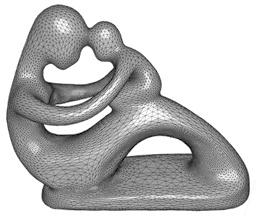 Abstract: We present a novel method to generate high-quality simplicial meshes with specified anisotropy. Given a surface or volumetric domain equipped with a Riemannian metric that encodes the desired anisotropy, we transform the problem to one of functional approximation. We construct a convex function over each mesh simplex whose Hessian locally matches the Riemannian metric, and iteratively adapt vertex positions and mesh connectivity to minimize the difference between the target convex functions and their piecewise-linear interpolation over the mesh. Our method generalizes optimal Delaunay triangulation and leads to a simple and efficient algorithm. We demonstrate its quality and speed compared to state-of-the-art methods on a variety of domains and metrics.
Abstract: We present a novel method to generate high-quality simplicial meshes with specified anisotropy. Given a surface or volumetric domain equipped with a Riemannian metric that encodes the desired anisotropy, we transform the problem to one of functional approximation. We construct a convex function over each mesh simplex whose Hessian locally matches the Riemannian metric, and iteratively adapt vertex positions and mesh connectivity to minimize the difference between the target convex functions and their piecewise-linear interpolation over the mesh. Our method generalizes optimal Delaunay triangulation and leads to a simple and efficient algorithm. We demonstrate its quality and speed compared to state-of-the-art methods on a variety of domains and metrics. -
Nikunj Raghuvanshi, John Snyder, ACM SIGGRAPH 2014. ©ACM 2014.
Keywords: wave equation, diffraction, scattering, room acoustics, early decay time, reverberation time, occlusion, obstruction, exclusion, parametric reverb, impulse response, convolution, environmental effects, DSP.
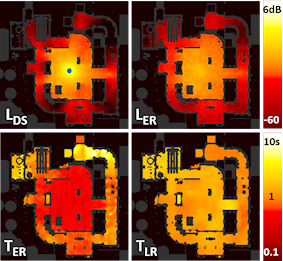 Abstract: The acoustic wave field in a complex scene is a chaotic 7D function of time and the positions of source and listener, making it difficult to compress and interpolate. This hampers precomputed approaches which tabulate impulse responses (IRs) to allow immersive, real-time sound propagation in static scenes. We code the field of time-varying IRs in terms of a few perceptual parameters derived from the IR’s energy decay. The resulting parameter fields are spatially smooth and compressed using a lossless scheme similar to PNG. We show that this encoding removes two of the seven dimensions, making it possible to handle large scenes such as entire game maps within 100MB of memory. Run-time decoding is fast, taking 100us per source. We introduce an efficient and scalable method for convolutionally rendering acoustic parameters that generates artifact-free audio even for fast motion and sudden changes in reverberance. We demonstrate convincing spatially-varying effects in complex scenes including occlusion/obstruction and reverberation, in our system integrated with Unreal Engine 3TM.
Abstract: The acoustic wave field in a complex scene is a chaotic 7D function of time and the positions of source and listener, making it difficult to compress and interpolate. This hampers precomputed approaches which tabulate impulse responses (IRs) to allow immersive, real-time sound propagation in static scenes. We code the field of time-varying IRs in terms of a few perceptual parameters derived from the IR’s energy decay. The resulting parameter fields are spatially smooth and compressed using a lossless scheme similar to PNG. We show that this encoding removes two of the seven dimensions, making it possible to handle large scenes such as entire game maps within 100MB of memory. Run-time decoding is fast, taking 100us per source. We introduce an efficient and scalable method for convolutionally rendering acoustic parameters that generates artifact-free audio even for fast motion and sudden changes in reverberance. We demonstrate convincing spatially-varying effects in complex scenes including occlusion/obstruction and reverberation, in our system integrated with Unreal Engine 3TM. -
Yang Liu, Hao Pan, John Snyder, Wenping Wang, Baining Guo, ACM SIGGRAPH 2013. ©ACM 2013.
Keywords: power diagram, reciprocal diagram, stress potential.
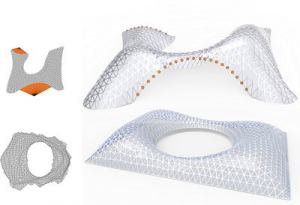 Abstract: Masonry structures must be compressively self-supporting; designing such surfaces forms an important topic in architecture as well as a challenging problem in geometric modeling. Under certain conditions, a surjective mapping exists between a power diagram, defined by a set of 2D vertices and associated weights, and the reciprocal diagram that characterizes the force diagram of a discrete self-supporting network. This observation lets us define a new and convenient parameterization for the space of self-supporting networks. Based on it and the discrete geometry of this design space, we present novel geometry processing methods including surface smoothing and remeshing which significantly reduce the magnitude of force densities and homogenize their distribution.
Abstract: Masonry structures must be compressively self-supporting; designing such surfaces forms an important topic in architecture as well as a challenging problem in geometric modeling. Under certain conditions, a surjective mapping exists between a power diagram, defined by a set of 2D vertices and associated weights, and the reciprocal diagram that characterizes the force diagram of a discrete self-supporting network. This observation lets us define a new and convenient parameterization for the space of self-supporting networks. Based on it and the discrete geometry of this design space, we present novel geometry processing methods including surface smoothing and remeshing which significantly reduce the magnitude of force densities and homogenize their distribution. -
Brian Guenter, Mark Finch, Steven Drucker, Desney Tan, John Snyder, ACM SIGGRAPH Asia 2012. ©ACM 2012.
Keywords: antialiasing, eccentricity, minimum angle of resolution (MAR), multiresolution gaze-contingent display (MGCD).
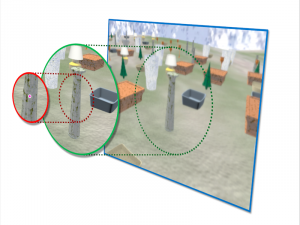 Abstract: We exploit the falloff of acuity in the visual periphery to accelerate graphics computation by a factor of 5-6 on a desktop HD display (1920×1080). Our method tracks the user’s gaze point and renders three image layers around it at progressively higher angular size but lower sampling rate. The three layers are then magnified to display resolution and smoothly composited. We develop a general and efficient antialiasing algorithm easily retrofitted into existing graphics code to minimize “twinkling” artifacts in the lower-resolution layers. A standard psychophysical model for acuity falloff assumes that minimum detectable angular size increases linearly as a function of eccentricity. Given the slope characterizing this falloff, we automatically compute layer sizes and sampling rates. The result looks like a full-resolution image but reduces the number of pixels shaded by a factor of 10-15.
Abstract: We exploit the falloff of acuity in the visual periphery to accelerate graphics computation by a factor of 5-6 on a desktop HD display (1920×1080). Our method tracks the user’s gaze point and renders three image layers around it at progressively higher angular size but lower sampling rate. The three layers are then magnified to display resolution and smoothly composited. We develop a general and efficient antialiasing algorithm easily retrofitted into existing graphics code to minimize “twinkling” artifacts in the lower-resolution layers. A standard psychophysical model for acuity falloff assumes that minimum detectable angular size increases linearly as a function of eccentricity. Given the slope characterizing this falloff, we automatically compute layer sizes and sampling rates. The result looks like a full-resolution image but reduces the number of pixels shaded by a factor of 10-15.We performed a user study to validate these results. It identifies two levels of foveation quality: a more conservative one in which users reported foveated rendering quality as equivalent to or better than non-foveated when directly shown both, and a more aggressive one in which users were unable to correctly label as increasing or decreasing a short quality progression relative to a high-quality foveated reference. Based on this user study, we obtain a slope value for the model of 1.32-1.65 arc minutes per degree of eccentricity. This allows us to predict two future advantages of foveated rendering: (1) bigger savings with larger, sharper displays than exist currently (e.g. 100 times speedup at a field of view of 70° and resolution matching foveal acuity), and (2) a roughly linear (rather than quadratic or worse) increase in rendering cost with increasing display field of view, for planar displays at a constant sharpness.
[paper] [supp (user study)] [download] [watch video] [talk] [project page]
-
Lifeng Zhu, Weiwei Xu, John Snyder, Yang Liu, Guoping Wang, Baining Guo, ACM SIGGRAPH Asia 2012. ©ACM2012.
Keywords: forward and inverse kinematics, MCAD, mechanism synthesis, simulated annealing.
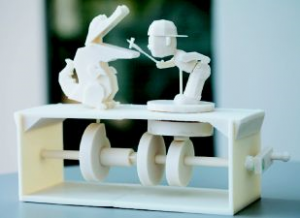 Abstract: We introduce a new method to synthesize mechanical toys solely from the motion of their features. The designer specifies the geometry and a time-varying rotation and translation of each rigid feature component. Our algorithm automatically generates a mechanism assembly located in a box below the feature base that produces the specified motion. Parts in the assembly are selected from a parameterized set including belt-pulleys, gears, crank-sliders, quickreturns, and various cams (snail, ellipse, and double-ellipse). Positions and parameters for these parts are optimized to generate the specified motion, minimize a simple measure of complexity, and yield a well-distributed layout of parts over the driving axes. Our solution uses a special initialization procedure followed by simulated annealing to efficiently search the complex configuration space for an optimal assembly.
Abstract: We introduce a new method to synthesize mechanical toys solely from the motion of their features. The designer specifies the geometry and a time-varying rotation and translation of each rigid feature component. Our algorithm automatically generates a mechanism assembly located in a box below the feature base that produces the specified motion. Parts in the assembly are selected from a parameterized set including belt-pulleys, gears, crank-sliders, quickreturns, and various cams (snail, ellipse, and double-ellipse). Positions and parameters for these parts are optimized to generate the specified motion, minimize a simple measure of complexity, and yield a well-distributed layout of parts over the driving axes. Our solution uses a special initialization procedure followed by simulated annealing to efficiently search the complex configuration space for an optimal assembly. -
Mark Finch, John Snyder, Hugues Hoppe, ACM SIGGRAPH Asia 2011. ©ACM 2011.
Keywords: bilaplacian/biharmonic PDE, slope/contour curves.
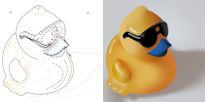 Abstract: Recent work defines vector graphics using diffusion between colored curves. We explore higher-order fairing to enable more natural interpolation and greater expressive control. Specifically, we build on thin-plate splines which provide smoothness everywhere except at user-specified tears and creases (discontinuities in value and derivative respectively). Our system lets a user sketch discontinuity curves without fixing their colors, and sprinkle color constraints at sparse interior points to obtain smooth interpolation subject to the outlines. We refine the representation with novel contour and slope curves, which anisotropically constrain interpolation derivatives. Compound curves further increase editing power by expanding a single curve into multiple offsets of various basic types (value, tear, crease, slope, and contour). The vector constraints are discretized over an image grid, and satisfied using a hierarchical solver. We demonstrate interactive authoring on a desktop CPU.
Abstract: Recent work defines vector graphics using diffusion between colored curves. We explore higher-order fairing to enable more natural interpolation and greater expressive control. Specifically, we build on thin-plate splines which provide smoothness everywhere except at user-specified tears and creases (discontinuities in value and derivative respectively). Our system lets a user sketch discontinuity curves without fixing their colors, and sprinkle color constraints at sparse interior points to obtain smooth interpolation subject to the outlines. We refine the representation with novel contour and slope curves, which anisotropically constrain interpolation derivatives. Compound curves further increase editing power by expanding a single curve into multiple offsets of various basic types (value, tear, crease, slope, and contour). The vector constraints are discretized over an image grid, and satisfied using a hierarchical solver. We demonstrate interactive authoring on a desktop CPU. -
Peiran Ren, Jiaping Wang, John Snyder, Xin Tong, Baining Guo, ACM SIGGRAPH 2011. ©ACM 2011.
Keywords: BRDF chart, dynamic time warping (DTW), local linear embedding, reflectance sequence/response, spatially varying BRDF (SVBRDF).
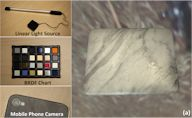 Abstract: We present a simple, fast solution for reflectance acquisition using tools that fit into a pocket. Our method captures video of a flat target surface from a fixed video camera lit by a hand-held, moving, linear light source. After processing, we obtain an SVBRDF.
Abstract: We present a simple, fast solution for reflectance acquisition using tools that fit into a pocket. Our method captures video of a flat target surface from a fixed video camera lit by a hand-held, moving, linear light source. After processing, we obtain an SVBRDF.We introduce a BRDF chart, analogous to a color “checker” chart, which arranges a set of known-BRDF reference tiles over a small card. A sequence of light responses from the chart tiles as well as from points on the target is captured and matched to reconstruct the target’s appearance.
We develop a new algorithm for BRDF reconstruction which works directly on these LDR responses, without knowing the light or camera position, or acquiring HDR lighting. It compensates for spatial variation caused by the local (finite distance) camera and light position by warping responses over time to align them to a specular reference. After alignment, we find an optimal linear combination of the Lambertian and purely specular reference responses to match each target point’s response. The same weights are then applied to the corresponding (known) reference BRDFs to reconstruct the target point’s BRDF. We extend the basic algorithm to also recover varying surface normals by adding two spherical caps for diffuse and specular references to the BRDF chart.
We demonstrate convincing results obtained after less than 30 seconds of data capture, using commercial mobile phone cameras in a casual environment.
-
Yue Dong, Jiaping Wang, Xin Tong, John Snyder, Yanxiang Lan, Moshe Ben-Ezra, Baining Guo, ACM SIGGRAPH 2010. ©ACM 2010.
Keywords: BRDF, local linear embedding (LLE), microfacet model, normal distribution function (NDF), reflectance acquisition.
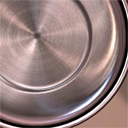 Abstract: Manifold bootstrapping is a new method for data-driven modeling of real-world, spatially-varying reflectance, based on the idea that reflectance over a given material sample forms a low-dimensional manifold. It provides a high-resolution result in both the spatial and angular domains by decomposing reflectance measurement into two lower-dimensional phases. The first acquires representatives of high angular dimension but sampled sparsely over the surface, while the second acquires keys of low angular dimension but sampled densely over the surface.
Abstract: Manifold bootstrapping is a new method for data-driven modeling of real-world, spatially-varying reflectance, based on the idea that reflectance over a given material sample forms a low-dimensional manifold. It provides a high-resolution result in both the spatial and angular domains by decomposing reflectance measurement into two lower-dimensional phases. The first acquires representatives of high angular dimension but sampled sparsely over the surface, while the second acquires keys of low angular dimension but sampled densely over the surface.We develop a hand-held, high-speed BRDF capturing device for phase one measurements. A condenser-based optical setup collects a dense hemisphere of rays emanating from a single point on the target sample as it is manually scanned over it, yielding 10 BRDF point measurements per second. Lighting directions from 6 LEDs are applied at each measurement; these are amplified to a full 4D BRDF using the general (NDF-tabulated) microfacet model. The second phase captures N=20-200 images of the entire sample from a fixed view and lit by a varying area source. We show that the resulting N-dimensional keys capture much of the distance information in the original BRDF space, so that they effectively discriminate among representatives, though they lack sufficient angular detail to reconstruct the SVBRDF by themselves. At each surface position, a local linear combination of a small number of neighboring representatives is computed to match each key, yielding a high-resolution SVBRDF. A quick capture session (10-20 minutes) on simple devices yields results showing sharp and anisotropic specularity and rich spatial detail.
-
Nikunj Raghuvanshi, John Snyder, Ravish Mehra, Ming Lin, Naga Govindaraju, ACM SIGGRAPH 2010. ©ACM 2010.
Keywords: acoustic propagation, convolution, early reflections, impulse response, late reverberation, peak detection.
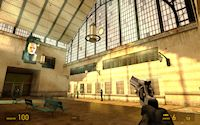 Abstract: We present a method for real-time sound propagation that captures all wave effects, including diffraction and reverberation, for multiple moving sources and a moving listener in a complex, static 3D scene. It performs an offline numerical simulation over the scene and then applies a novel technique to extract and compactly encode the perceptually salient information in the resulting acoustic responses. Each response is automatically broken into two phases: early reflections (ER) and late reverberation (LR), via a threshold on the temporal density of arriving wavefronts. The LR is simulated and stored in the frequency domain, once per room in the scene. The ER accounts for more detailed spatial variation, by recording a set of peak delays/amplitudes in the time domain and a residual frequency response sampled in octave frequency bands, at each source/receiver point pair in a 5D grid. An efficient run-time uses this precomputed representation to perform binaural sound rendering based on frequency-domain convolution. Our system demonstrates realistic, wave-based acoustic effects in real time, including diffraction low-passing behind obstructions, sound focusing, hollow reverberation in empty rooms, sound diffusion in fully-furnished rooms, and realistic late reverberation.
Abstract: We present a method for real-time sound propagation that captures all wave effects, including diffraction and reverberation, for multiple moving sources and a moving listener in a complex, static 3D scene. It performs an offline numerical simulation over the scene and then applies a novel technique to extract and compactly encode the perceptually salient information in the resulting acoustic responses. Each response is automatically broken into two phases: early reflections (ER) and late reverberation (LR), via a threshold on the temporal density of arriving wavefronts. The LR is simulated and stored in the frequency domain, once per room in the scene. The ER accounts for more detailed spatial variation, by recording a set of peak delays/amplitudes in the time domain and a residual frequency response sampled in octave frequency bands, at each source/receiver point pair in a 5D grid. An efficient run-time uses this precomputed representation to perform binaural sound rendering based on frequency-domain convolution. Our system demonstrates realistic, wave-based acoustic effects in real time, including diffraction low-passing behind obstructions, sound focusing, hollow reverberation in empty rooms, sound diffusion in fully-furnished rooms, and realistic late reverberation. -
Jiaping Wang, Peiran Ren, Minmin Gong, John Snyder, Baining Guo, ACM SIGGRAPH Asia 2009. ©ACM 2009.
Keywords: environmental lighting, microfacet model, normal distribution function (NDF), shadows, spatially-varying bi-directional reflectance distribution function (SVBRDF), spherical Gaussian, spherical signed distance function (SSDF), texture map.
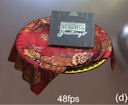 Abstract: We describe a technique for real-time rendering of dynamic, spatially-varying BRDFs in static scenes with all-frequency shadows from environmental and point lights. The 6D SVBRDF is represented with a general microfacet model and spherical lobes fit to its 4D spatially-varying normal distribution function (SVNDF). A sum of spherical Gaussians (SGs) provides an accurate approximation with a small number of lobes. Parametric BRDFs are fit on-the-fly using simple analytic expressions; measured BRDFs are fit as a preprocess using nonlinear optimization. Our BRDF representation is compact, allows detailed textures, is closed under products and rotations, and supports reflectance of arbitrarily high specularity. At run-time, SGs representing the NDF are warped to align the half-angle vector to the lighting direction and multiplied by the microfacet shadowing and Fresnel factors. This yields the relevant 2D view slice on-the-fly at each pixel, still represented in the SG basis. We account for macro-scale shadowing using a new, nonlinear visibility representation based on spherical signed distance functions (SSDFs). SSDFs allow per-pixel interpolation of high-frequency visibility without ghosting and can be multiplied by the BRDF and lighting efficiently on the GPU.
Abstract: We describe a technique for real-time rendering of dynamic, spatially-varying BRDFs in static scenes with all-frequency shadows from environmental and point lights. The 6D SVBRDF is represented with a general microfacet model and spherical lobes fit to its 4D spatially-varying normal distribution function (SVNDF). A sum of spherical Gaussians (SGs) provides an accurate approximation with a small number of lobes. Parametric BRDFs are fit on-the-fly using simple analytic expressions; measured BRDFs are fit as a preprocess using nonlinear optimization. Our BRDF representation is compact, allows detailed textures, is closed under products and rotations, and supports reflectance of arbitrarily high specularity. At run-time, SGs representing the NDF are warped to align the half-angle vector to the lighting direction and multiplied by the microfacet shadowing and Fresnel factors. This yields the relevant 2D view slice on-the-fly at each pixel, still represented in the SG basis. We account for macro-scale shadowing using a new, nonlinear visibility representation based on spherical signed distance functions (SSDFs). SSDFs allow per-pixel interpolation of high-frequency visibility without ghosting and can be multiplied by the BRDF and lighting efficiently on the GPU. -
Derek Nowrouzezahrai, John Snyder, Special Issue of Computer Graphics Forum: Eurographics Symposium on Rendering, June 2009. ©Eurographics 2009.
Keywords: horizon map, inter-reflections, multi-resolution pyramid, normalized Legendre polynomial, spherical harmonics, visibility wedge.
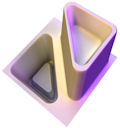 Abstract: We present a real-time method for rendering global illumination effects from large area and environmental lights on dynamic height fields. In contrast to previous work, our method handles inter-reflections (indirect lighting) and non-diffuse surfaces. To reduce sampling, we construct one multi-resolution pyramid for height variation to compute direct shadows, and another pyramid for each indirect bounce of incident radiance to compute interreflections. The basic principle is to sample the points blocking direct light, or shedding indirect light, from coarser levels of the pyramid the farther away they are from a given receiver point. We unify the representation of visibility and indirect radiance at discrete azimuthal directions (i.e., as a function of a single elevation angle) using the concept of a “casting set” of visible points along this direction whose contributions are collected in the basis of normalized Legendre polynomials. This analytic representation is compact, requires no precomputation, and allows efficient integration to produce the spherical visibility and indirect radiance signals. Sub-sampling visibility and indirect radiance, while shading with full-resolution surface normals, further increases performance without introducing noticeable artifacts. Our method renders 512×512 height fields (>500K triangles) at 36Hz.
Abstract: We present a real-time method for rendering global illumination effects from large area and environmental lights on dynamic height fields. In contrast to previous work, our method handles inter-reflections (indirect lighting) and non-diffuse surfaces. To reduce sampling, we construct one multi-resolution pyramid for height variation to compute direct shadows, and another pyramid for each indirect bounce of incident radiance to compute interreflections. The basic principle is to sample the points blocking direct light, or shedding indirect light, from coarser levels of the pyramid the farther away they are from a given receiver point. We unify the representation of visibility and indirect radiance at discrete azimuthal directions (i.e., as a function of a single elevation angle) using the concept of a “casting set” of visible points along this direction whose contributions are collected in the basis of normalized Legendre polynomials. This analytic representation is compact, requires no precomputation, and allows efficient integration to produce the spherical visibility and indirect radiance signals. Sub-sampling visibility and indirect radiance, while shading with full-resolution surface normals, further increases performance without introducing noticeable artifacts. Our method renders 512×512 height fields (>500K triangles) at 36Hz. -
Jiaping Wang, Shuang Zhao, Xin Tong, John Snyder, Baining Guo, ACM SIGGRAPH, 27(3), 41:1-41:9, August 2008. ©ACM 2008.
Keywords: BRDF acquisition, normal distribution function (NDF), spatially-varying, bi-directional reflectance distribution function (SVBRDF).
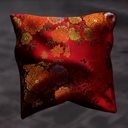 Abstract: We present a new technique for the visual modeling of spatially-varying anisotropic reflectance using data captured from a single view. Reflectance is represented using a microfacet-based BRDF which tabulates the facets’ normal distribution (NDF) as a function of surface location. Data from a single view provides a 2D slice of the 4D BRDF at each surface point from which we fit a partial NDF. The fitted NDF is partial because the single view direction coupled with the set of light directions covers only a portion of the “half-angle” hemisphere. We complete the NDF at each point by applying a novel variant of texture synthesis using similar, overlapping partial NDFs from other points. Our similarity measure allows azimuthal rotation of partial NDFs, under the assumption that reflectance is spatially redundant but the local frame may be arbitrarily oriented. Our system includes a simple acquisition device that collects images over a 2D set of light directions by scanning a linear array of LEDs over a flat sample. Results demonstrate that our approach preserves spatial and directional BRDF details and generates a visually compelling match to measured materials.
Abstract: We present a new technique for the visual modeling of spatially-varying anisotropic reflectance using data captured from a single view. Reflectance is represented using a microfacet-based BRDF which tabulates the facets’ normal distribution (NDF) as a function of surface location. Data from a single view provides a 2D slice of the 4D BRDF at each surface point from which we fit a partial NDF. The fitted NDF is partial because the single view direction coupled with the set of light directions covers only a portion of the “half-angle” hemisphere. We complete the NDF at each point by applying a novel variant of texture synthesis using similar, overlapping partial NDFs from other points. Our similarity measure allows azimuthal rotation of partial NDFs, under the assumption that reflectance is spatially redundant but the local frame may be arbitrarily oriented. Our system includes a simple acquisition device that collects images over a 2D set of light directions by scanning a linear array of LEDs over a flat sample. Results demonstrate that our approach preserves spatial and directional BRDF details and generates a visually compelling match to measured materials. -
John Snyder, Derek Nowrouzezahrai, Eurographics Symposium on Rendering, June 2008. ©Eurographics 2008.
Keywords: horizon map, multi-resolution pyramid, multi-scale derivative, spherical harmonics, visibility wedge.
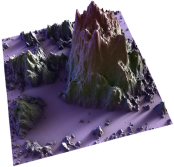 Abstract: We present a new, real-time method for rendering soft shadows from large light sources or lighting environments on dynamic height fields. The method first computes a horizon map for a set of azimuthal directions. To reduce sampling, we compute a multi-resolution pyramid on the height field. Coarser pyramid levels are indexed as the distance from caster to receiver increases. For every receiver point and every azimuthal direction, a smooth function of blocking angle in terms of log distance is reconstructed from a height difference sample at each pyramid level. This function’s maximum approximates the horizon angle. We then sum visibility at each receiver point over wedges determined by successive pairs of horizon angles. Each wedge represents a linear transition in blocking angle over its azimuthal extent. It is precomputed in the order-4 spherical harmonic (SH) basis, for a canonical azimuthal origin and fixed extent, resulting in a 2D table. The SH triple product of 16D vectors representing lighting, total visibility, and diffuse reflectance then yields the soft-shadowed result. Two types of light sources are considered; both are distant and low-frequency. Environmental lights require visibility sampling around the complete 360 degree azimuth, while key lights sample visibility within a partial swath. Restricting the swath concentrates samples where the light comes from (e.g. 3 azimuthal directions vs. 16-32 for a full swath) and obtains sharper shadows. Our GPU implementation handles height fields up to 1024×1024 in real-time. The computation is simple, local, and parallel, with performance independent of geometric content.
Abstract: We present a new, real-time method for rendering soft shadows from large light sources or lighting environments on dynamic height fields. The method first computes a horizon map for a set of azimuthal directions. To reduce sampling, we compute a multi-resolution pyramid on the height field. Coarser pyramid levels are indexed as the distance from caster to receiver increases. For every receiver point and every azimuthal direction, a smooth function of blocking angle in terms of log distance is reconstructed from a height difference sample at each pyramid level. This function’s maximum approximates the horizon angle. We then sum visibility at each receiver point over wedges determined by successive pairs of horizon angles. Each wedge represents a linear transition in blocking angle over its azimuthal extent. It is precomputed in the order-4 spherical harmonic (SH) basis, for a canonical azimuthal origin and fixed extent, resulting in a 2D table. The SH triple product of 16D vectors representing lighting, total visibility, and diffuse reflectance then yields the soft-shadowed result. Two types of light sources are considered; both are distant and low-frequency. Environmental lights require visibility sampling around the complete 360 degree azimuth, while key lights sample visibility within a partial swath. Restricting the swath concentrates samples where the light comes from (e.g. 3 azimuthal directions vs. 16-32 for a full swath) and obtains sharper shadows. Our GPU implementation handles height fields up to 1024×1024 in real-time. The computation is simple, local, and parallel, with performance independent of geometric content. -
Peter-Pike Sloan, Naga Govindaraju, Derek Nowrouzezahrai, John Snyder, Pacific Graphics, 97-105, October 2007. ©IEEE 2007.
Keywords: bilateral filtering, indirect lighting, receiver buffer, soft shadows, sphere of influence, spherical blocker/re-radiator, spherical harmonic exponentiation, splatting.
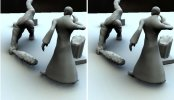 Abstract: We present a new, general, and real-time technique for soft global illumination in low-frequency environmental lighting. It accumulates over relatively few spherical proxies which approximate the light blocking and re-radiating effect of dynamic geometry. Soft shadows are computed by accumulating log visibility vectors for each sphere proxy as seen by each receiver point. Inter-reflections are computed by accumulating vectors representing the proxy’s unshadowed radiance when illuminated by the environment. Both vectors capture low-frequency directional dependence using the spherical harmonic basis. We also present a new proxy accumulation strategy that splats each proxy to receiver pixels in image space to collect its shadowing and indirect lighting contribution. Our soft GI rendering pipeline unifies direct and indirect soft effects with a simple accumulation strategy that maps entirely to the GPU and outperforms previous vertex-based methods.
Abstract: We present a new, general, and real-time technique for soft global illumination in low-frequency environmental lighting. It accumulates over relatively few spherical proxies which approximate the light blocking and re-radiating effect of dynamic geometry. Soft shadows are computed by accumulating log visibility vectors for each sphere proxy as seen by each receiver point. Inter-reflections are computed by accumulating vectors representing the proxy’s unshadowed radiance when illuminated by the environment. Both vectors capture low-frequency directional dependence using the spherical harmonic basis. We also present a new proxy accumulation strategy that splats each proxy to receiver pixels in image space to collect its shadowing and indirect lighting contribution. Our soft GI rendering pipeline unifies direct and indirect soft effects with a simple accumulation strategy that maps entirely to the GPU and outperforms previous vertex-based methods. -
Kun Zhou, Qiming Hou, MinMin Gong, John Snyder, Baining Guo, Heung-Yeung Shum, Pacific Graphics, 116-128, October 2007. ©IEEE 2007.
Keywords: airlight, fog, Gaussian, participating media, radial basis function (RBF).
 Abstract: We describe a new, analytic approximation to the airlight integral from scattering media whose density is modeled as a sum of Gaussians. The approximation supports real-time rendering of inhomogeneous media including their shadowing and scattering effects. For each Gaussian, this approximation samples the scattering integrand at the projection of its center along the view ray but models attenuation and shadowing with respect to the other Gaussians by integrating density along the fixed path from light source to 3D center to view point. Our approach handles isotropic, single-scattering media illuminated by point light sources or low-frequency environmental lighting. We also generalize models for reflectance of surfaces from constant-density to inhomogeneous media, using simple optical depth averaging in the direction of the light source or all around the receiver point. Our real-time rendering approach is incorporated into a system for real-time design and preview of realistic, animated fog, steam, or smoke.
Abstract: We describe a new, analytic approximation to the airlight integral from scattering media whose density is modeled as a sum of Gaussians. The approximation supports real-time rendering of inhomogeneous media including their shadowing and scattering effects. For each Gaussian, this approximation samples the scattering integrand at the projection of its center along the view ray but models attenuation and shadowing with respect to the other Gaussians by integrating density along the fixed path from light source to 3D center to view point. Our approach handles isotropic, single-scattering media illuminated by point light sources or low-frequency environmental lighting. We also generalize models for reflectance of surfaces from constant-density to inhomogeneous media, using simple optical depth averaging in the direction of the light source or all around the receiver point. Our real-time rendering approach is incorporated into a system for real-time design and preview of realistic, animated fog, steam, or smoke.Note: see more recent work in Pacific Graphics 2008: “Gradient-based Interpolation and Sampling for Real-Time Rendering of Inhomogeneous, Single-Scattering Media”, by my colleagues Zhong Ren, Kun Zhou, Stephen Lin, and Baining Guo. This work is also able to simulate light shafts.
-
Rui Wang, Kun Zhou, John Snyder, Xinguo Liu, Hujun Bao, Qunsheng Peng, Baining Guo, The Visual Computer, 22(9-11), 612-621, September 2006. ©Springer-Verlag 2006.
Keywords: collision/proximity detection, outside volume, soft shadows.
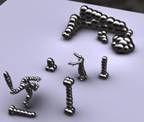 Abstract: We approximate a solid object represented as a triangle mesh by a bounding set of spheres having minimal summed volume outside the object. We show how outside volume for a single sphere can be computed using a simple integration over the object’s triangles. We then minimize the total outside volume over all spheres in the set using a variant of iterative Lloyd clustering which splits the mesh points into sets and bounds each with an outside volume-minimizing sphere. The resulting sphere sets are tighter than those of previous methods. In experiments comparing against a state-of-the-art alter- native (adaptive medial axis), our method often requires half or fewer as many spheres to obtain the same error, under a variety of error metrics including total outside volume, shadowing fidelity, and proximity measurement.
Abstract: We approximate a solid object represented as a triangle mesh by a bounding set of spheres having minimal summed volume outside the object. We show how outside volume for a single sphere can be computed using a simple integration over the object’s triangles. We then minimize the total outside volume over all spheres in the set using a variant of iterative Lloyd clustering which splits the mesh points into sets and bounds each with an outside volume-minimizing sphere. The resulting sphere sets are tighter than those of previous methods. In experiments comparing against a state-of-the-art alter- native (adaptive medial axis), our method often requires half or fewer as many spheres to obtain the same error, under a variety of error metrics including total outside volume, shadowing fidelity, and proximity measurement. -
Zhong Ren, Rui Wang, John Snyder, Kun Zhou, Xinguo Liu, Bo Sun, Peter-Pike Sloan, Hujun Bao, Qunsheng Peng, Baining Guo, ACM SIGGRAPH, 977-986, August 2006. ©ACM 2006.
Keywords: ambient occlusion, low-frequency lighting environment, global illumination, hybrid algorithm (HYB), matrix exponential, optimal linear approximation (OL), product series, scaling/squaring, self-shadowing, SHEXP, SH logarithm, SH visibility vector, Volterra series.
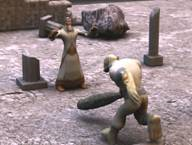 Abstract: Previous methods for soft shadows numerically integrate over many light directions at each receiver point, testing blocker visibility in each direction. We introduce a method for real-time soft shadows in dynamic scenes illuminated by large, low-frequency light sources where such integration is impractical. Our method operates on vectors representing low-frequency visibility of blockers in the spherical harmonic basis. Blocking geometry is modeled as a set of spheres; relatively few spheres capture the low-frequency blocking effect of complicated geometry. At each receiver point, we compute the product of visibility vectors for these blocker spheres as seen from the point. Instead of computing an expensive SH product per blocker as in previous work, we perform inexpensive vector sums to accumulate the log of blocker visibility. SH exponentiation then yields the product visibility vector over all blockers. We show how the SH exponentiation required can be approximated accurately and efficiently for low-order SH, accelerating previous CPU-based methods by a factor of 10 or more, depending on blocker complexity, and allowing real-time GPU implementation.
Abstract: Previous methods for soft shadows numerically integrate over many light directions at each receiver point, testing blocker visibility in each direction. We introduce a method for real-time soft shadows in dynamic scenes illuminated by large, low-frequency light sources where such integration is impractical. Our method operates on vectors representing low-frequency visibility of blockers in the spherical harmonic basis. Blocking geometry is modeled as a set of spheres; relatively few spheres capture the low-frequency blocking effect of complicated geometry. At each receiver point, we compute the product of visibility vectors for these blocker spheres as seen from the point. Instead of computing an expensive SH product per blocker as in previous work, we perform inexpensive vector sums to accumulate the log of blocker visibility. SH exponentiation then yields the product visibility vector over all blockers. We show how the SH exponentiation required can be approximated accurately and efficiently for low-order SH, accelerating previous CPU-based methods by a factor of 10 or more, depending on blocker complexity, and allowing real-time GPU implementation.[paper] [watch video] [talk (Siggraph)] [talk (GameFest)] [supplement] [poster]
-
John Snyder, Microsoft Research Technical Report, MSR-TR-2006-53, May 2006.
Keywords: order-3, sparse, symmetric, triple product, tensor.
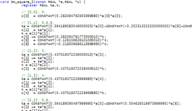 Abstract: We present a method for fast evaluation of spherical harmonic (SH) products or, more generally, any binary product of vectors yielding a vector, where the product is governed by a fixed, sparse, symmetric, order 3 tensor, denoted Γijk. The method is given the nonzero entries of Γ as input (they can be computed analytically or by numerical integration for the SH basis) and makes use of an offline code generator to perform the necessary array indexing using constants rather than variables. Factoring is performed by collecting the tensor’s nonzero components, represented by index triples (i,j,k), into groups (i,j,k1), (i,j,k2), …,(i,j,kNij) which share a common pair of indices (i,j) in the triple, and which vary only in the third (completion) index km and its corresponding coefficient dm=Γijkm where mÎ{1,2,…,Nij}. The collection is done using a greedy method that successively chooses the index pair (i,j) maximizing the number Nij of different km needed to complete the tensor’s nonzero index triples. The greedy method then continues to the next best initial pair, generates its contribution, and so on, until all nonzero triples have been accounted for. The combination of “greedy pair” factoring and generating constant array indices produces code that is significantly faster than naïve evaluation methods.
Abstract: We present a method for fast evaluation of spherical harmonic (SH) products or, more generally, any binary product of vectors yielding a vector, where the product is governed by a fixed, sparse, symmetric, order 3 tensor, denoted Γijk. The method is given the nonzero entries of Γ as input (they can be computed analytically or by numerical integration for the SH basis) and makes use of an offline code generator to perform the necessary array indexing using constants rather than variables. Factoring is performed by collecting the tensor’s nonzero components, represented by index triples (i,j,k), into groups (i,j,k1), (i,j,k2), …,(i,j,kNij) which share a common pair of indices (i,j) in the triple, and which vary only in the third (completion) index km and its corresponding coefficient dm=Γijkm where mÎ{1,2,…,Nij}. The collection is done using a greedy method that successively chooses the index pair (i,j) maximizing the number Nij of different km needed to complete the tensor’s nonzero index triples. The greedy method then continues to the next best initial pair, generates its contribution, and so on, until all nonzero triples have been accounted for. The combination of “greedy pair” factoring and generating constant array indices produces code that is significantly faster than naïve evaluation methods. -
Jiaping Wang, Xin Tong, John Snyder, Yanyun Chen, Baining Guo, Heung-Yeung Shum, The Visual Computer, 21(8-10), 559-568, August 2005. ©Springer-Verlag 2005.
Keywords: bidirectional texture functions (BTFs), meso-structure distance function (MDF), reflectance and shading models, rendering, shadow algorithms, texture mapping.
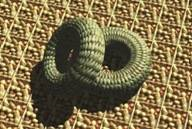 Abstract: Bidirectional texture functions, or BTFs, accurately model reflectance variation at a fine (meso-) scale as a function of lighting and viewing direction. BTFs also capture view-dependent visibility variation, also called masking or parallax, but only within surface contours. Meso-structure detail is neglected at silhouettes, so BTF-mapped objects retain the coarse shape of the underlying model.
Abstract: Bidirectional texture functions, or BTFs, accurately model reflectance variation at a fine (meso-) scale as a function of lighting and viewing direction. BTFs also capture view-dependent visibility variation, also called masking or parallax, but only within surface contours. Meso-structure detail is neglected at silhouettes, so BTF-mapped objects retain the coarse shape of the underlying model.We augment BTF rendering to obtain approximate meso-scale silhouettes. Our new representation, the 4D meso-structure distance function (MDF), tabulates the displacement from a reference frame where a ray first intersects the meso-scale geometry beneath as a function of ray direction and ray position along that reference plane. Given an MDF, the meso-structure silhouette can be rendered with a per-pixel depth peeling process on graphics hardware, while shading and local parallax are handled by the BTF. Our approach allows real-time rendering, handles complex, non-height-field meso-structure, requires that no additional geometry be sent to the rasterizer other than the mesh triangles, is more compact than textured visibility representations used previously, and, for the first time, can be easily measured from physical samples. We also adapt the algorithm to capture detailed shadows cast both by and onto BTF-mapped surfaces. We demonstrate the efficiency of our algorithm on a variety of BTF data, including real data acquired using our BTF–MDF measurement system.
-
Peter-Pike Sloan, Ben Luna, John Snyder, ACM SIGGRAPH, 1216-1224, July 2005. ©ACM 2005.
Keywords: LDPRT, low-frequency lighting environment, nonlinear optimization, spherical harmonics, soft shadows, subsurface scattering, texture map, zonal harmonics.
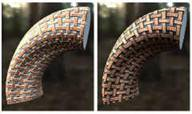 Abstract: Precomputed radiance transfer (PRT) captures realistic lighting effects from distant, low-frequency environmental lighting but has been limited to static models or precomputed sequences. We focus on PRT for local effects such as bumps, wrinkles, or other detailed features, but extend it to arbitrarily deformable models. Our approach applies zonal harmonics (ZH) which approximate spherical functions as sums of circularly symmetric Legendre polynomials around different axes. By spatially varying both the axes and coefficients of these basis functions, we can fit to spatially varying transfer signals. Compared to the spherical harmonic (SH) basis, the ZH basis yields a more compact approximation. More important, it can be trivially rotated whereas SH rotation is expensive and unsuited for dense per-vertex or per-pixel evaluation. This property allows, for the first time, PRT to be mapped onto deforming models which re-orient the local coordinate frame. We generate ZH transfer models by fitting to PRT signals simulated on meshes or simple parametric models for thin membranes and wrinkles. We show how shading with ZH transfer can be significantly accelerated by specializing to a given lighting environment. Finally, we demonstrate real-time rendering results with soft shadows, inter-reflections, and subsurface scatter on deforming models.
Abstract: Precomputed radiance transfer (PRT) captures realistic lighting effects from distant, low-frequency environmental lighting but has been limited to static models or precomputed sequences. We focus on PRT for local effects such as bumps, wrinkles, or other detailed features, but extend it to arbitrarily deformable models. Our approach applies zonal harmonics (ZH) which approximate spherical functions as sums of circularly symmetric Legendre polynomials around different axes. By spatially varying both the axes and coefficients of these basis functions, we can fit to spatially varying transfer signals. Compared to the spherical harmonic (SH) basis, the ZH basis yields a more compact approximation. More important, it can be trivially rotated whereas SH rotation is expensive and unsuited for dense per-vertex or per-pixel evaluation. This property allows, for the first time, PRT to be mapped onto deforming models which re-orient the local coordinate frame. We generate ZH transfer models by fitting to PRT signals simulated on meshes or simple parametric models for thin membranes and wrinkles. We show how shading with ZH transfer can be significantly accelerated by specializing to a given lighting environment. Finally, we demonstrate real-time rendering results with soft shadows, inter-reflections, and subsurface scatter on deforming models.Note: exposed in the D3DX library of DirectX 9 (LDPRT).
Note: in hindsight, I wished we had called this “reorientable” PRT rather than “deformable”, since the essence of our representation is to allow fast rotation of the local radiance transfer.
-
Kun Zhou, Jin Huang, John Snyder, Xinguo Liu, Hujun Bao, Baining Guo, Heung-Yeung Shum, ACM SIGGRAPH, 496-503, July 2005. ©ACM 2005.
Keywords: cartoon motion mapping, differential domain methods, deformation retargeting, local transform propagation, volumetric details.
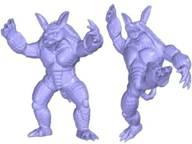 Abstract: We present a novel technique for large deformations on 3D meshes using the volumetric graph Laplacian. We first construct a graph representing the volume inside the input mesh. The graph need not form a solid meshing of the input mesh’s interior; its edges simply connect nearby points in the volume. This graph’s Laplacian encodes volumetric details as the difference between each point in the graph and the average of its neighbors. Preserving these volumetric details during deformation imposes a volumetric constraint that prevents unnatural changes in volume. We also include in the graph points a short distance outside the mesh to avoid local self-intersections. Volumetric detail preservation is represented by a quadric energy function. Minimizing it preserves details in a least-squares sense, distributing error uniformly over the whole deformed mesh. It can also be combined with conventional constraints involving surface positions, details or smoothness, and efficiently minimized by solving a sparse linear system.
Abstract: We present a novel technique for large deformations on 3D meshes using the volumetric graph Laplacian. We first construct a graph representing the volume inside the input mesh. The graph need not form a solid meshing of the input mesh’s interior; its edges simply connect nearby points in the volume. This graph’s Laplacian encodes volumetric details as the difference between each point in the graph and the average of its neighbors. Preserving these volumetric details during deformation imposes a volumetric constraint that prevents unnatural changes in volume. We also include in the graph points a short distance outside the mesh to avoid local self-intersections. Volumetric detail preservation is represented by a quadric energy function. Minimizing it preserves details in a least-squares sense, distributing error uniformly over the whole deformed mesh. It can also be combined with conventional constraints involving surface positions, details or smoothness, and efficiently minimized by solving a sparse linear system.We apply this technique in a 2D curve-based deformation system allowing novice users to create pleasing deformations with little effort. A novel application of this system is to apply nonrigid and exaggerated deformations of 2D cartoon characters to 3D meshes. We demonstrate our system’s potential with several examples.
-
Kun Zhou, John Snyder, Baining Guo, Heung-Yeung Shum, ACM Symposium on Geometry Processing, 45-54, July 2004. ©ACM 2004.
Keywords: atlas, chartification, eigenanalysis, graph cut, isomap, multi-chart geometry image, signal-specialized parameterization, texture atlas, texture synthesis.
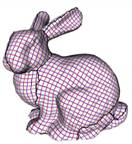 Abstract: We describe a fully automatic method, called iso-charts, to create texture atlases on arbitrary meshes. It is the first to consider stretch not only when parameterizing charts, but also when forming charts. The output atlas bounds stretch by a user-specified constant, allowing the user to balance the number of charts against their stretch. Our approach combines two seemingly incompatible techniques: stretch-minimizing parameterization, based on the surface integral of the trace of the local metric tensor, and the “isomap” or MDS (multi-dimensional scaling) parameterization, based on an eigen-analysis of the matrix of squared geodesic distances between pairs of mesh vertices. We show that only a few iterations of nonlinear stretch optimization need be applied to the MDS parameterization to obtain low-stretch atlases. The close relationship we discover between these two parameterizations also allows us to apply spectral clustering based on MDS to partition the mesh into charts having low stretch. We also novelly apply the graph cut algorithm in optimizing chart boundaries to further minimize stretch, follow sharp features, and avoid meandering. Overall, our algorithm creates texture atlases quickly, with fewer charts and lower stretch than previous methods, providing improvement in applications like geometric remeshing. We also describe an extension, signal-specialized atlas creation, to efficiently sample surface signals, and show for the first time that considering signal stretch in chart formation produces better texture maps.
Abstract: We describe a fully automatic method, called iso-charts, to create texture atlases on arbitrary meshes. It is the first to consider stretch not only when parameterizing charts, but also when forming charts. The output atlas bounds stretch by a user-specified constant, allowing the user to balance the number of charts against their stretch. Our approach combines two seemingly incompatible techniques: stretch-minimizing parameterization, based on the surface integral of the trace of the local metric tensor, and the “isomap” or MDS (multi-dimensional scaling) parameterization, based on an eigen-analysis of the matrix of squared geodesic distances between pairs of mesh vertices. We show that only a few iterations of nonlinear stretch optimization need be applied to the MDS parameterization to obtain low-stretch atlases. The close relationship we discover between these two parameterizations also allows us to apply spectral clustering based on MDS to partition the mesh into charts having low stretch. We also novelly apply the graph cut algorithm in optimizing chart boundaries to further minimize stretch, follow sharp features, and avoid meandering. Overall, our algorithm creates texture atlases quickly, with fewer charts and lower stretch than previous methods, providing improvement in applications like geometric remeshing. We also describe an extension, signal-specialized atlas creation, to efficiently sample surface signals, and show for the first time that considering signal stretch in chart formation produces better texture maps. -
Geetika Tewari, John Snyder, Pedro Sander, Steven Gortler, Hugues Hoppe, ACM Symposium on Geometry Processing, 55-64, July 2004. ©ACM 2004.
Keywords: atlas, chart, integrated metric tensor, second derivative, surface signal, texture map.
 Abstract: We propose a metric for surface parameterization specialized to its signal that can be used to create more efficient, high-quality texture maps. Derived from Taylor expansion of signal error, our metric predicts the signal approximation error — the difference between the original surface signal and its reconstruction from the sampled texture. Unlike previous methods, our metric assumes piecewise-linear reconstruction, and thus makes a good approximation to bilinear reconstruction employed in graphics hardware. We achieve significant savings in texture area for a desired signal accuracy compared to the signal-specialized parameterization metric proposed by Sander et al. in the 2002 Eurographics Workshop on Rendering.
Abstract: We propose a metric for surface parameterization specialized to its signal that can be used to create more efficient, high-quality texture maps. Derived from Taylor expansion of signal error, our metric predicts the signal approximation error — the difference between the original surface signal and its reconstruction from the sampled texture. Unlike previous methods, our metric assumes piecewise-linear reconstruction, and thus makes a good approximation to bilinear reconstruction employed in graphics hardware. We achieve significant savings in texture area for a desired signal accuracy compared to the signal-specialized parameterization metric proposed by Sander et al. in the 2002 Eurographics Workshop on Rendering. -
Xinguo Liu, Peter-Pike Sloan, Heung-Yeung Shum, John Snyder, Eurographics Symposium on Rendering, 337-334, June 2004. ©Eurographics 2004.
Keywords: BRDF factorization, clustered principal component analysis (CPCA), global illumination, Haar wavelet lighting basis over cube maps, PRT, transfer matrix.
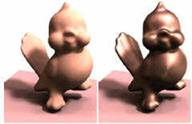 Abstract: We introduce a method based on precomputed radiance transfer (PRT) that allows interactive rendering of glossy surfaces and includes shadowing effects from dynamic, “all-frequency” lighting. Specifically, source lighting is represented by a cube map at resolution nL = 6×32×32. We present a novel PRT formulation which factors glossy BRDFs into purely view-dependent and light-dependent parts, achieving reasonable accuracy with only m=10 dimensional factors. We then tabulate an m×nL transfer matrix at each surface vertex as a preprocess, representing the object’s response to this lighting. Because this surface signal is so high-dimensional, reducing m is crucial for making practical both the preprocessing and run-time. To compress the transfer matrices, we divide the cube map into 24 lighting segments and apply the Haar wavelet basis in each segment to provide sensible quantization. We also apply clustered principal component analysis (CPCA) to each PRT segment to approximate it as a linear combination of a few (n=16) representative transfer matrices within a small set of clusters over the surface. This exploits spatial coherence to compress very effectively. Most important, it maintains fast rendering rates with 2-3 orders of magnitude more lighting coefficients than previous methods, which increases accuracy and avoids temporal artifacts in high-frequency lighting environments. We demonstrate interactive performance (1-5Hz) on models having up to 50,000 vertices.
Abstract: We introduce a method based on precomputed radiance transfer (PRT) that allows interactive rendering of glossy surfaces and includes shadowing effects from dynamic, “all-frequency” lighting. Specifically, source lighting is represented by a cube map at resolution nL = 6×32×32. We present a novel PRT formulation which factors glossy BRDFs into purely view-dependent and light-dependent parts, achieving reasonable accuracy with only m=10 dimensional factors. We then tabulate an m×nL transfer matrix at each surface vertex as a preprocess, representing the object’s response to this lighting. Because this surface signal is so high-dimensional, reducing m is crucial for making practical both the preprocessing and run-time. To compress the transfer matrices, we divide the cube map into 24 lighting segments and apply the Haar wavelet basis in each segment to provide sensible quantization. We also apply clustered principal component analysis (CPCA) to each PRT segment to approximate it as a linear combination of a few (n=16) representative transfer matrices within a small set of clusters over the surface. This exploits spatial coherence to compress very effectively. Most important, it maintains fast rendering rates with 2-3 orders of magnitude more lighting coefficients than previous methods, which increases accuracy and avoids temporal artifacts in high-frequency lighting environments. We demonstrate interactive performance (1-5Hz) on models having up to 50,000 vertices. -
Peter-Pike Sloan, Jesse Hall, John Hart, John Snyder, ACM SIGGRAPH, 382-391, July 2003. ©ACM 2003.
Keywords: clustered principal component analysis (CPCA), graphics hardware, low-frequency environmental lighting, global illumination, Monte Carlo techniques, principal component analysis (PCA), PRT, shadows, vector quantization (VQ).
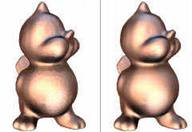 Abstract: We compress storage and accelerate performance of precomputed radiance transfer (PRT), which captures the way an object shadows, scatters, and reflects light. PRT records over many surface points a transfer matrix. At run-time, this matrix transforms a vector of spherical harmonic coefficients representing distant, low-frequency source lighting into exiting radiance. Per-point transfer matrices form a high-dimensional surface signal that we compress using clustered principal component analysis (CPCA), which partitions many samples into fewer clusters each approximating the signal as an affine subspace. CPCA thus reduces the high-dimensional transfer signal to a low-dimensional set of per-point weights on a per-cluster set of representative matrices. Rather than computing a weighted sum of representatives and applying this result to the lighting, we apply the representatives to the lighting per-cluster (on the CPU) and weight these results per-point (on the GPU). Since the output of the matrix is lower-dimensional than the matrix itself, this reduces computation. We also increase the accuracy of encoded radiance functions with a new least-squares optimal projection of spherical harmonics onto the hemisphere. We describe an implementation on graphics hardware that performs real-time rendering of glossy objects with dynamic self-shadowing and inter-reflection without fixing the view or light as in previous work. Our approach also allows significantly increased lighting frequency when rendering diffuse objects and includes subsurface scattering.
Abstract: We compress storage and accelerate performance of precomputed radiance transfer (PRT), which captures the way an object shadows, scatters, and reflects light. PRT records over many surface points a transfer matrix. At run-time, this matrix transforms a vector of spherical harmonic coefficients representing distant, low-frequency source lighting into exiting radiance. Per-point transfer matrices form a high-dimensional surface signal that we compress using clustered principal component analysis (CPCA), which partitions many samples into fewer clusters each approximating the signal as an affine subspace. CPCA thus reduces the high-dimensional transfer signal to a low-dimensional set of per-point weights on a per-cluster set of representative matrices. Rather than computing a weighted sum of representatives and applying this result to the lighting, we apply the representatives to the lighting per-cluster (on the CPU) and weight these results per-point (on the GPU). Since the output of the matrix is lower-dimensional than the matrix itself, this reduces computation. We also increase the accuracy of encoded radiance functions with a new least-squares optimal projection of spherical harmonics onto the hemisphere. We describe an implementation on graphics hardware that performs real-time rendering of glossy objects with dynamic self-shadowing and inter-reflection without fixing the view or light as in previous work. Our approach also allows significantly increased lighting frequency when rendering diffuse objects and includes subsurface scattering. -
Peter-Pike Sloan, Xinguo Liu, Heung-Yeung Shum, John Snyder, ACM SIGGRAPH, 370-375, July 2003. ©ACM 2003.
Keywords: bidirectional texture function (BTF), graphics hardware, global illumination, id map, meso-scale and macro-scale, multi-resolution modeling, low-frequency environmental lighting, precomputed radiance transfer (PRT), radiance transfer texture (RTT), shadows, texture synthesis, transfer matrix.
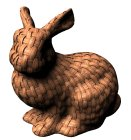 Abstract: Radiance transfer represents how generic source lighting is shadowed and scattered by an object to produce view-dependent appearance. We generalize by rendering transfer at two scales. A macro-scale is coarsely sampled over an object’s surface, providing global effects like shadows cast from an arm onto a body. A meso-scale is finely sampled over a small patch to provide local texture. Low-order (25D) spherical harmonics represent low-frequency lighting dependence for both scales. To render, a coefficient vector representing distant source lighting is first transformed at the macro-scale by a matrix at each vertex of a coarse mesh. The resulting vectors represent a spatially-varying hemisphere of lighting incident to the meso-scale. A 4D function, called a radiance transfer texture (RTT), then specifies the surface’s meso-scale response to each lighting basis component, as a function of a spatial index and a view direction. Finally, a 25D dot product of the macro-scale result vector with the vector looked up from the RTT performs the correct shading integral. We use an id map to place RTT samples from a small patch over the entire object; only two scalars are specified at high spatial resolution. Results show that bi-scale decomposition makes preprocessing practical and efficiently renders self-shadowing and inter-reflection effects from dynamic, low-frequency light sources at both scales.
Abstract: Radiance transfer represents how generic source lighting is shadowed and scattered by an object to produce view-dependent appearance. We generalize by rendering transfer at two scales. A macro-scale is coarsely sampled over an object’s surface, providing global effects like shadows cast from an arm onto a body. A meso-scale is finely sampled over a small patch to provide local texture. Low-order (25D) spherical harmonics represent low-frequency lighting dependence for both scales. To render, a coefficient vector representing distant source lighting is first transformed at the macro-scale by a matrix at each vertex of a coarse mesh. The resulting vectors represent a spatially-varying hemisphere of lighting incident to the meso-scale. A 4D function, called a radiance transfer texture (RTT), then specifies the surface’s meso-scale response to each lighting basis component, as a function of a spatial index and a view direction. Finally, a 25D dot product of the macro-scale result vector with the vector looked up from the RTT performs the correct shading integral. We use an id map to place RTT samples from a small patch over the entire object; only two scalars are specified at high spatial resolution. Results show that bi-scale decomposition makes preprocessing practical and efficiently renders self-shadowing and inter-reflection effects from dynamic, low-frequency light sources at both scales. -
Pedro Sander, Zoë Wood, Steven Gortler, John Snyder, Hugues Hoppe, ACM Symposium on Geometry Processing, 146-155, June 2003. ©ACM 2003.
Keywords: atlas, chart, MCGIM, piecewise parameterization, stretch metric, texture atlas, zippering.
 Abstract: We introduce multi-chart geometry images, a new representation for arbitrary surfaces. It is created by resampling a surface onto a regular 2D grid. Whereas the original scheme of Gu et al. maps the entire surface onto a single square, we use an atlas construction to map the surface piecewise onto charts of arbitrary shape. We demonstrate that this added flexibility reduces parametrization distortion and thus provides greater geometric fidelity, particularly for shapes with long extremities, high genus, or disconnected components. Traditional atlas constructions suffer from discontinuous reconstruction across chart boundaries, which in our context create unacceptable surface cracks. Our solution is a novel zippering algorithm that creates a watertight surface. In addition, we present a new atlas chartification scheme based on clustering optimization.
Abstract: We introduce multi-chart geometry images, a new representation for arbitrary surfaces. It is created by resampling a surface onto a regular 2D grid. Whereas the original scheme of Gu et al. maps the entire surface onto a single square, we use an atlas construction to map the surface piecewise onto charts of arbitrary shape. We demonstrate that this added flexibility reduces parametrization distortion and thus provides greater geometric fidelity, particularly for shapes with long extremities, high genus, or disconnected components. Traditional atlas constructions suffer from discontinuous reconstruction across chart boundaries, which in our context create unacceptable surface cracks. Our solution is a novel zippering algorithm that creates a watertight surface. In addition, we present a new atlas chartification scheme based on clustering optimization. -
Peter-Pike Sloan, Jan Kautz, John Snyder, ACM SIGGRAPH, 527-536, July 2002. ©ACM 2002.
Keywords: graphics hardware, global illumination, Monte Carlo techniques, neighborhood transfer, PRT, self transfer, soft shadows, transfer matrix, transfer vector.
 Abstract: We present a new, real-time method for rendering diffuse and glossy objects in low-frequency lighting environments that captures soft shadows, inter-reflections, and caustics. As a preprocess, a novel global transport simulator creates functions over the object’s surface representing transfer of arbitrary, low-frequency incident lighting into transferred radiance which includes global effects like shadows and inter-reflections from the object onto itself. At run-time, these transfer functions are applied to actual incident lighting. Dynamic, local lighting is handled by sampling it close to the object every frame; the object can also be rigidly rotated with respect to the lighting and vice versa. Lighting and transfer functions are represented using low-order spherical harmonics. This avoids aliasing and evaluates efficiently on graphics hardware by reducing the shading integral to a dot product of 9 to 25 element vectors for diffuse receivers. Glossy objects are handled using matrices rather than vectors. We further introduce functions for radiance transfer from a dynamic lighting environment through a preprocessed object to neighboring points in space. These allow soft shadows and caustics from rigidly moving objects to be cast onto arbitrary, dynamic receivers. We demonstrate real-time global lighting effects with this approach.
Abstract: We present a new, real-time method for rendering diffuse and glossy objects in low-frequency lighting environments that captures soft shadows, inter-reflections, and caustics. As a preprocess, a novel global transport simulator creates functions over the object’s surface representing transfer of arbitrary, low-frequency incident lighting into transferred radiance which includes global effects like shadows and inter-reflections from the object onto itself. At run-time, these transfer functions are applied to actual incident lighting. Dynamic, local lighting is handled by sampling it close to the object every frame; the object can also be rigidly rotated with respect to the lighting and vice versa. Lighting and transfer functions are represented using low-order spherical harmonics. This avoids aliasing and evaluates efficiently on graphics hardware by reducing the shading integral to a dot product of 9 to 25 element vectors for diffuse receivers. Glossy objects are handled using matrices rather than vectors. We further introduce functions for radiance transfer from a dynamic lighting environment through a preprocessed object to neighboring points in space. These allow soft shadows and caustics from rigidly moving objects to be cast onto arbitrary, dynamic receivers. We demonstrate real-time global lighting effects with this approach.Note: exposed in the in the D3DX library of DirectX 9 (PRT).
[paper (pdf)] [paper (doc)] [watch video] [talk (Siggraph)] [talk (overview)] [poster] [wiki]
-
Pedro Sander, Steven Gortler, John Snyder, Hugues Hoppe, Eurographics Workshop on Rendering, 87-98, June 2002. ©Eurographics 2002.
Keywords: atlas, chart, integrated metric tensor, Jacobian, piecewise parameterization, stretch metric, surface signal, texture map.
Note: exposed in the D3DX library of DirectX 9 (UVAtlas).
 Abstract: To reduce memory requirements for texture mapping a model, we build a surface parametrization specialized to its signal (such as color or normal). Intuitively, we want to allocate more texture samples in regions with greater signal detail. Our approach is to minimize signal approximation error — the difference between the original surface signal and its reconstruction from the sampled texture. Specifically, our signal-stretch parametrization metric is derived from a Taylor expansion of signal error. For fast evaluation, this metric is pre-integrated over the surface as a metric tensor. We minimize this nonlinear metric using a novel coarse-to-fine hierarchical solver, further accelerated with a fine-to-coarse propagation of the integrated metric tensor. Use of metric tensors permits anisotropic squashing of the parametrization along directions of low signal gradient. Texture area can often be reduced by a factor of 4 for a desired signal accuracy compared to nonspecialized parametrizations.
Abstract: To reduce memory requirements for texture mapping a model, we build a surface parametrization specialized to its signal (such as color or normal). Intuitively, we want to allocate more texture samples in regions with greater signal detail. Our approach is to minimize signal approximation error — the difference between the original surface signal and its reconstruction from the sampled texture. Specifically, our signal-stretch parametrization metric is derived from a Taylor expansion of signal error. For fast evaluation, this metric is pre-integrated over the surface as a metric tensor. We minimize this nonlinear metric using a novel coarse-to-fine hierarchical solver, further accelerated with a fine-to-coarse propagation of the integrated metric tensor. Use of metric tensors permits anisotropic squashing of the parametrization along directions of low signal gradient. Texture area can often be reduced by a factor of 4 for a desired signal accuracy compared to nonspecialized parametrizations. -
Peter-Pike Sloan, Jan Kautz, John Snyder, Eurographics Workshop on Rendering, 291-296, June 2002. ©Eurographics 2002.
Keywords: global illumination, precomputed radiance transfer (PRT), rendering on graphics hardware, shadows.
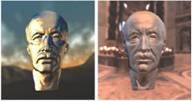 Abstract: Real-time shading using general (e.g., anisotropic) BRDFs has so far been limited to a few point or directional light sources. We extend such shading to smooth, area lighting using a low-order spherical harmonic basis for the lighting environment. We represent the 4D product function of BRDF times the cosine factor (dot product of the incident lighting and surface normal vectors) as a 2D table of spherical harmonic coefficients. Each table entry represents, for a single view direction, the integral of this product function times lighting on the hemisphere expressed in spherical harmonics. This reduces the shading integral to a simple dot product of 25 component vectors, easily evaluatable on PC graphics hardware. Non-trivial BRDF models require rotating the lighting coefficients to a local frame at each point on an object, currently forming the computational bottleneck. Real-time results can be achieved by fixing the view to allow dynamic lighting or vice versa. We also generalize a previous method for precomputed radiance transfer to handle general BRDF shading. This provides shadows and inter-reflections that respond in real-time to lighting changes on a preprocessed object of arbitrary material (BRDF) type.
Abstract: Real-time shading using general (e.g., anisotropic) BRDFs has so far been limited to a few point or directional light sources. We extend such shading to smooth, area lighting using a low-order spherical harmonic basis for the lighting environment. We represent the 4D product function of BRDF times the cosine factor (dot product of the incident lighting and surface normal vectors) as a 2D table of spherical harmonic coefficients. Each table entry represents, for a single view direction, the integral of this product function times lighting on the hemisphere expressed in spherical harmonics. This reduces the shading integral to a simple dot product of 25 component vectors, easily evaluatable on PC graphics hardware. Non-trivial BRDF models require rotating the lighting coefficients to a local frame at each point on an object, currently forming the computational bottleneck. Real-time results can be achieved by fixing the view to allow dynamic lighting or vice versa. We also generalize a previous method for precomputed radiance transfer to handle general BRDF shading. This provides shadows and inter-reflections that respond in real-time to lighting changes on a preprocessed object of arbitrary material (BRDF) type.Note: SH rotation algorithm cited in a theoretical physics paper.
-
Pedro Sander, John Snyder, Steven Gortler, Hugues Hoppe, ACM SIGGRAPH, 409-416, August 2001. ©ACM 2001.
Keywords: atlas, chart, geometric stretch, mesh simplification, packing, surface parameterization, stretch metric, surface signal, texture stretch.
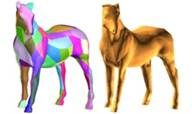 Abstract: Given an arbitrary mesh, we present a method to construct a progressive mesh (PM) such that all meshes in the PM sequence share a common texture parametrization. Our method considers two important goals simultaneously. It minimizes texture stretch (small texture distances mapped onto large surface distances) to balance sampling rates over all locations and directions on the surface. It also minimizes texture deviation (“slippage” error based on parametric correspondence) to obtain accurate textured mesh approximations. The method begins by partitioning the mesh into charts using planarity and compactness heuristics. It creates a stretch-minimizing parametrization within each chart, and resizes the charts based on the resulting stretch. Next, it simplifies the mesh while respecting the chart boundaries. The parametrization is re-optimized to reduce both stretch and deviation over the whole PM sequence. Finally, the charts are packed into a texture atlas. We demonstrate using such atlases to sample color and normal maps over several models.
Abstract: Given an arbitrary mesh, we present a method to construct a progressive mesh (PM) such that all meshes in the PM sequence share a common texture parametrization. Our method considers two important goals simultaneously. It minimizes texture stretch (small texture distances mapped onto large surface distances) to balance sampling rates over all locations and directions on the surface. It also minimizes texture deviation (“slippage” error based on parametric correspondence) to obtain accurate textured mesh approximations. The method begins by partitioning the mesh into charts using planarity and compactness heuristics. It creates a stretch-minimizing parametrization within each chart, and resizes the charts based on the resulting stretch. Next, it simplifies the mesh while respecting the chart boundaries. The parametrization is re-optimized to reduce both stretch and deviation over the whole PM sequence. Finally, the charts are packed into a texture atlas. We demonstrate using such atlases to sample color and normal maps over several models. -
Ziyad Hakura, John Snyder, Proceedings of the 12th Eurographics Workshop on Rendering Techniques, 289-300, June 2001. ©Eurographics 2001.
Keywords: adaptive tessellation, graphics hardware, interactive rendering, ray tracing.
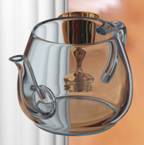 Abstract: We introduce hybrid rendering, a scheme that dynamically ray traces the local geometry of reflective and refractive objects, but approximates more distant geometry by hardware-supported environment maps (EMs). To limit computation, we use a greedy ray path shading model that prunes the binary ray tree generated by refractive objects to form just two ray paths. We also restrict ray queries to triangle vertices, but perform adaptive tessellation to shoot additional rays where neighboring ray paths differ sufficiently. By using layered, parameterized EMs that are inferred over a set of viewpoint samples to match ray traced imagery, we accurately handle parallax and view-dependent shading in the environment. We increase robustness of EMs by inferring them simultaneously across multiple viewpoints and including environmental geometry that is occluded from the viewpoint sample but is revealed in nearby viewpoints. We demonstrate realistic shiny and glass objects with a user-controlled viewpoint.
Abstract: We introduce hybrid rendering, a scheme that dynamically ray traces the local geometry of reflective and refractive objects, but approximates more distant geometry by hardware-supported environment maps (EMs). To limit computation, we use a greedy ray path shading model that prunes the binary ray tree generated by refractive objects to form just two ray paths. We also restrict ray queries to triangle vertices, but perform adaptive tessellation to shoot additional rays where neighboring ray paths differ sufficiently. By using layered, parameterized EMs that are inferred over a set of viewpoint samples to match ray traced imagery, we accurately handle parallax and view-dependent shading in the environment. We increase robustness of EMs by inferring them simultaneously across multiple viewpoints and including environmental geometry that is occluded from the viewpoint sample but is revealed in nearby viewpoints. We demonstrate realistic shiny and glass objects with a user-controlled viewpoint. -
Ziyad Hakura, John Snyder, Jerome Lengyel, Symposium on Interactive 3D Graphics, 327-334, March 2001. ©ACM 2001.
Keywords: Fresnel modulation, image-based rendering (IBR), parameterized texture maps (PTMs), ray tracing, reflections, self-reflections, surface light fields.
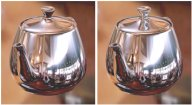 Abstract: Static environment maps fail to capture local reflections including effects like self-reflections and parallax in the reflected imagery. We instead propose parameterized environment maps (PEMs), a set of per-view environment maps which accurately reproduce local reflections at each viewpoint as computed by an offline ray tracer. Even with a small set of viewpoint samples, PEMs support plausible movement away from and between the pre-rendered viewpoint samples while maintaining local reflections. They also make use of environment maps supported in graphics hardware to provide real-time exploration of the pre-rendered space. In addition to parameterization by viewpoint, our notion of PEM extends to general, multidimensional parameterizations of the scene, including relative motions of objects and lighting changes.
Abstract: Static environment maps fail to capture local reflections including effects like self-reflections and parallax in the reflected imagery. We instead propose parameterized environment maps (PEMs), a set of per-view environment maps which accurately reproduce local reflections at each viewpoint as computed by an offline ray tracer. Even with a small set of viewpoint samples, PEMs support plausible movement away from and between the pre-rendered viewpoint samples while maintaining local reflections. They also make use of environment maps supported in graphics hardware to provide real-time exploration of the pre-rendered space. In addition to parameterization by viewpoint, our notion of PEM extends to general, multidimensional parameterizations of the scene, including relative motions of objects and lighting changes.Our contributions include a technique for inferring environment maps providing a close match to ray-traced imagery. We also explicitly infer and encode all MIPMAP levels of the PEMs to achieve higher accuracy. We propose layered environment maps that separate local and distant reflected geometry. We explore several types of environment maps including finite spheres, ellipsoids, and boxes that better approximate the environmental geometry. We demonstrate results showing faithful local reflections in an interactive viewer.
-
Pedro Sander, Hugues Hoppe, John Snyder, Steven Gortler, ACM Symposium on Interactive 3D Graphics, 167-174, March 2001. ©ACM 2001.
Keywords: antialiased line rendering, filtering, mesh antialiasing, supersampling, triangle mesh rendering.
 Abstract: Aliasing is an important problem when rendering triangle meshes. Efficient antialiasing techniques such as mipmapping greatly improve the filtering of textures defined over a mesh. A major component of the remaining aliasing occurs along discontinuity edges such as silhouettes, creases, and material boundaries. Framebuffer supersampling is a simple remedy, but 2×2 super-sampling leaves behind significant temporal artifacts, while greater supersampling demands even more fill-rate and memory. We present an alternative that focuses effort on discontinuity edges by overdrawing such edges as antialiased lines. Although the idea is simple, several subtleties arise. Visible silhouette edges must be detected efficiently. Discontinuity edges need consistent orientations. They must be blended as they approach the silhouette to avoid popping. Unfortunately, edge blending results in blurriness. Our technique balances these two competing objectives of temporal smoothness and spatial sharpness. Finally, the best results are obtained when discontinuity edges are sorted by depth. Our approach proves surprisingly effective at reducing temporal artifacts commonly referred to as “crawling jaggies”, with little added cost.
Abstract: Aliasing is an important problem when rendering triangle meshes. Efficient antialiasing techniques such as mipmapping greatly improve the filtering of textures defined over a mesh. A major component of the remaining aliasing occurs along discontinuity edges such as silhouettes, creases, and material boundaries. Framebuffer supersampling is a simple remedy, but 2×2 super-sampling leaves behind significant temporal artifacts, while greater supersampling demands even more fill-rate and memory. We present an alternative that focuses effort on discontinuity edges by overdrawing such edges as antialiased lines. Although the idea is simple, several subtleties arise. Visible silhouette edges must be detected efficiently. Discontinuity edges need consistent orientations. They must be blended as they approach the silhouette to avoid popping. Unfortunately, edge blending results in blurriness. Our technique balances these two competing objectives of temporal smoothness and spatial sharpness. Finally, the best results are obtained when discontinuity edges are sorted by depth. Our approach proves surprisingly effective at reducing temporal artifacts commonly referred to as “crawling jaggies”, with little added cost. -
John Snyder, Don Mitchell, Microsoft Technical Report, 2001.
Keywords: cartography, environment map, Fourier transform, signal processing, singular value, surface parameterization, texture.
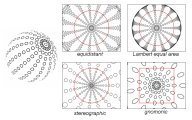 Abstract: Many functions can map images to the sphere for use as environment maps or spherical panoramas. We develop a new metric that asymptotically measures how well these maps use a given number of samples to provide the greatest worst-case frequency content of the image everywhere over the sphere. Since this metric assumes perfect reconstruction filtering even with highly anisotropic maps, we define another, conservative measure of sampling efficiency that penalizes anisotropy using the larger singular value of the mapping’s Jacobian. With these metrics, we compare spherical maps used previously in computer graphics as well as other mappings from cartography, and propose several new, simple mapping functions (dual equidistant and polar-capped maps) that are significantly more efficient and exhibit less anisotropy. This is true with respect to either efficiency metric, which we show agree in the worst case for all but one of the spherical maps presented. Although we apply the metrics to spherical mappings, they are useful for analyzing texture maps onto any 3D surface.
Abstract: Many functions can map images to the sphere for use as environment maps or spherical panoramas. We develop a new metric that asymptotically measures how well these maps use a given number of samples to provide the greatest worst-case frequency content of the image everywhere over the sphere. Since this metric assumes perfect reconstruction filtering even with highly anisotropic maps, we define another, conservative measure of sampling efficiency that penalizes anisotropy using the larger singular value of the mapping’s Jacobian. With these metrics, we compare spherical maps used previously in computer graphics as well as other mappings from cartography, and propose several new, simple mapping functions (dual equidistant and polar-capped maps) that are significantly more efficient and exhibit less anisotropy. This is true with respect to either efficiency metric, which we show agree in the worst case for all but one of the spherical maps presented. Although we apply the metrics to spherical mappings, they are useful for analyzing texture maps onto any 3D surface. -
Pedro Sander, Xianfeng Gu, Steven Gortler, Hugues Hoppe, John Snyder, ACM SIGGRAPH, 327-334, July 2000. ©ACM 2000.
Keywords: level of detail algorithms, rendering algorithms, texture mapping, triangle mesh simplification.
 Abstract: Approximating detailed models with coarse, texture-mapped meshes results in polygonal silhouettes. To eliminate this artifact, we introduce silhouette clipping, a framework for efficiently clipping the rendering of coarse geometry to the exact silhouette of the original model. The coarse mesh is obtained using progressive hulls, a novel representation with the nesting property required for proper clipping. We describe an improved technique for constructing texture and normal maps over this coarse mesh. Given a perspective view, silhouettes are efficiently extracted from the original mesh using a precomputed search tree. Within the tree, hierarchical culling is achieved using pairs of anchored cones. The extracted silhouette edges are used to set the hardware stencil buffer and alpha buffer, which in turn clip and antialias the rendered coarse geometry. Results demonstrate that silhouette clipping can produce renderings of similar quality to high-resolution meshes in less rendering time.
Abstract: Approximating detailed models with coarse, texture-mapped meshes results in polygonal silhouettes. To eliminate this artifact, we introduce silhouette clipping, a framework for efficiently clipping the rendering of coarse geometry to the exact silhouette of the original model. The coarse mesh is obtained using progressive hulls, a novel representation with the nesting property required for proper clipping. We describe an improved technique for constructing texture and normal maps over this coarse mesh. Given a perspective view, silhouettes are efficiently extracted from the original mesh using a precomputed search tree. Within the tree, hierarchical culling is achieved using pairs of anchored cones. The extracted silhouette edges are used to set the hardware stencil buffer and alpha buffer, which in turn clip and antialias the rendered coarse geometry. Results demonstrate that silhouette clipping can produce renderings of similar quality to high-resolution meshes in less rendering time. -
Ziyad Hakura, Jerome Lengyel, John Snyder, Proceedings of the Eurographics Workshop on Rendering Techniques, 101-112, June 2000. ©Springer-Verlag 2000.
Keywords: image-based rendering (IBR), layered rendering, least-squares texture map inference, multidimensional Laplacian pyramid, parameterized texture maps (PTM), ray tracing, surface light fields.
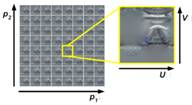 Abstract: We generalize image-based rendering by exploiting texture-mapping graphics hardware to decompress ray-traced “animations”. Rather than 1D time, our animations are parameterized by two or more arbitrary variables representing view/lighting changes and rigid object motions. To best match the graphics hardware rendering to the input ray-traced imagery, we describe a novel method to infer parameterized texture maps for each object by modeling the hardware as a linear system and then performing least-squares optimization. The parameterized textures are compressed as a multidimensional Laplacian pyramid on fixed size blocks of parameter space. This scheme captures the coherence in parameterized animations and, unlike previous work, decodes directly into texture maps that load into hardware with a few, simple image operations. We introduce adaptive dimension splitting in the Laplacian pyramid and separate diffuse and specular lighting layers to further improve compression. High-quality results are demonstrated at compression ratios up to 800:1 with interactive playback on current consumer graphics cards.
Abstract: We generalize image-based rendering by exploiting texture-mapping graphics hardware to decompress ray-traced “animations”. Rather than 1D time, our animations are parameterized by two or more arbitrary variables representing view/lighting changes and rigid object motions. To best match the graphics hardware rendering to the input ray-traced imagery, we describe a novel method to infer parameterized texture maps for each object by modeling the hardware as a linear system and then performing least-squares optimization. The parameterized textures are compressed as a multidimensional Laplacian pyramid on fixed size blocks of parameter space. This scheme captures the coherence in parameterized animations and, unlike previous work, decodes directly into texture maps that load into hardware with a few, simple image operations. We introduce adaptive dimension splitting in the Laplacian pyramid and separate diffuse and specular lighting layers to further improve compression. High-quality results are demonstrated at compression ratios up to 800:1 with interactive playback on current consumer graphics cards.[paper] [report] [summary] [talk (Ziyad Hakura’s PhD defense)] [talk_movies]
-
John Snyder, Jerome Lengyel, ACM SIGGRAPH, 219-230, July 1998. ©ACM 1998.
Keywords: depth of field, dynamic kd-tree, motion blur, non-splitting layered decomposition, occlusion cycle, occlusion graph, sprite, Talisman.
 Abstract: We present an efficient algorithm for visibility sorting a set of moving geometric objects into a sequence of image layers which are composited to produce the final image. Instead of splitting the geometry as in previous visibility approaches, we detect mutual occluders and resolve them using an appropriate image compositing expression or merge them into a single layer. Such an algorithm has many applications in computer graphics; we demonstrate two: rendering acceleration using image interpolation and visibility-correct depth of field using image blurring.
Abstract: We present an efficient algorithm for visibility sorting a set of moving geometric objects into a sequence of image layers which are composited to produce the final image. Instead of splitting the geometry as in previous visibility approaches, we detect mutual occluders and resolve them using an appropriate image compositing expression or merge them into a single layer. Such an algorithm has many applications in computer graphics; we demonstrate two: rendering acceleration using image interpolation and visibility-correct depth of field using image blurring.We propose a new, incremental method for identifying mutually occluding sets of objects and computing a visibility sort among these sets. Occlusion queries are accelerated by testing on convex bounding hulls; less conservative tests are also discussed. Kd-trees formed by combinations of directions in object or image space provide an initial cull on potential occluders, and incremental collision detection algorithms are adapted to resolve pairwise occlusions, when necessary. Mutual occluders are further analyzed to generate an image compositing expression; in the case of nonbinary occlusion cycles, an expression can always be generated without merging the objects into a single layer. Results demonstrate that the algorithm is practical for real-time animation of scenes involving hundreds of objects each comprising hundreds or thousands of polygons.
[paper] [talk] [supplementary technical report (MSR-TR-98-05)]
-
Jerome Lengyel, John Snyder, ACM SIGGRAPH, 233-242, August 1997. ©ACM 1997.
Keywords: affine transformation, fiducials, image compositing, image-based rendering, sprite, Talisman.
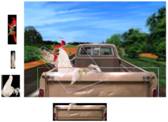 Abstract: For decades, animated cartoons and movie special effects have factored the rendering of a scene into layers that are updated independently and composed in the final display. We apply layer factorization to real-time computer graphics. The layers allow targeting of resources, whether the ink and paint artists of cartoons or the graphics pipeline as described here, to those parts of the scene that are most important.
Abstract: For decades, animated cartoons and movie special effects have factored the rendering of a scene into layers that are updated independently and composed in the final display. We apply layer factorization to real-time computer graphics. The layers allow targeting of resources, whether the ink and paint artists of cartoons or the graphics pipeline as described here, to those parts of the scene that are most important.To take advantage of frame-to-frame coherence, we generalize layer factorization to apply to both dynamic geometric objects and terms of the shading model, introduce new ways to trade off fidelity for resource use in individual layers, and show how to compute warps that reuse renderings for multiple frames. We describe quantities, called fiducials, that measure the fidelity of approximations to the original image. Layer update rates, spatial resolution, and other quality parameters are determined by geometric, photometric, visibility, and sampling fiducials weighted by the content author’s preferences. We also compare the fidelity of various types of reuse warps and demonstrate the suitability of the affine warp.
Using Talisman, a hardware architecture with an efficient layer primitive, the work presented here dramatically improves the geometric complexity and shading quality of scenes rendered in real-time.
-
Bradford Chamberlain, Tony DeRose, Dani Lischinski, David Salesin, John Snyder, Proceedings of the Conference on Graphics Interface ’96, 132-141, May 1996. ©Canadian Information Processing Society 1996.
Keywords: level-of-detail (LOD), multi-resolution, octree, rendering, spatial hierarchy, walkthrough.
 Abstract: We present a new method for accelerating the rendering of complex static scenes. The technique is applicable to unstructured scenes containing arbitrary geometric primitives and has sublinear asymptotic complexity. Our approach is to construct a spatial hierarchy of cells over the scene and to associate with each cell a simplified representation of its contents. The scene is then rendered using a traversal of the hierarchy in which a cell’s approximation is drawn instead of its contents if the approximation is sufficiently accurate. We apply the method to several different scenes and demonstrate significant speedups with little image degradation. We also exhibit and discuss some of the artifacts that our approximation may cause.
Abstract: We present a new method for accelerating the rendering of complex static scenes. The technique is applicable to unstructured scenes containing arbitrary geometric primitives and has sublinear asymptotic complexity. Our approach is to construct a spatial hierarchy of cells over the scene and to associate with each cell a simplified representation of its contents. The scene is then rendered using a traversal of the hierarchy in which a cell’s approximation is drawn instead of its contents if the approximation is sufficiently accurate. We apply the method to several different scenes and demonstrate significant speedups with little image degradation. We also exhibit and discuss some of the artifacts that our approximation may cause. -
Jonathan Shade, Dani Lischinski, David Salesin, Tony DeRose, John Snyder, ACM SIGGRAPH, 75-82, August 1996. ©ACM 1996.
Keywords: affine BSP-tree, image-based rendering, level-of-detail (LOD), path coherence, spatial hierarchy, texture mapping.
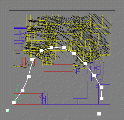 Abstract: We present a new method that utilizes path coherence to accelerate walkthroughs of geometrically complex static scenes. As a preprocessing step, our method constructs a BSP-tree that hierarchically partitions the geometric primitives in the scene. In the course of a walkthrough, images of nodes at various levels of the hierarchy are cached for reuse in subsequent frames. A cached image is reused by texture-mapping it onto a single quadrilateral that is drawn instead of the geometry contained in the corresponding node. Visual artifacts are kept under control by using an error metric that quantifies the discrepancy between the appearance of the geometry contained in a node and the cached image. The new method is shown to achieve speedups of an order of magnitude for walkthroughs of a complex outdoor scene, with little or no loss in rendering quality.
Abstract: We present a new method that utilizes path coherence to accelerate walkthroughs of geometrically complex static scenes. As a preprocessing step, our method constructs a BSP-tree that hierarchically partitions the geometric primitives in the scene. In the course of a walkthrough, images of nodes at various levels of the hierarchy are cached for reuse in subsequent frames. A cached image is reused by texture-mapping it onto a single quadrilateral that is drawn instead of the geometry contained in the corresponding node. Visual artifacts are kept under control by using an error metric that quantifies the discrepancy between the appearance of the geometry contained in a node and the cached image. The new method is shown to achieve speedups of an order of magnitude for walkthroughs of a complex outdoor scene, with little or no loss in rendering quality. -
John Snyder, Microsoft Research Technical Report, MSR-TR-96-11, March 1996.
Keywords: analytic models, boundary/contour integral, hemispherical light source, polygonal light source, spherical light source, Stoke’s theorem.
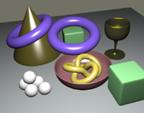 Abstract: In an effort to extend the sorts of lighting models used in real-time computer graphics, this paper presents several area light source models, including Lambertian and Phong illumination from constant and cosine-falloff hemispherical light sources, constant subhemispherical light sources, and constant polygonal light sources. The subhemispherical lighting model can also be used to represent illumination from finite-distance spherical light sources. The models are not unduly more expensive than the simple point light source models, and are capable of real-time evaluation.
Abstract: In an effort to extend the sorts of lighting models used in real-time computer graphics, this paper presents several area light source models, including Lambertian and Phong illumination from constant and cosine-falloff hemispherical light sources, constant subhemispherical light sources, and constant polygonal light sources. The subhemispherical lighting model can also be used to represent illumination from finite-distance spherical light sources. The models are not unduly more expensive than the simple point light source models, and are capable of real-time evaluation. -
John Snyder, ACM SIGGRAPH, 209-218, August 1995. ©ACM 1995.
Keywords: object placement/assembly, collision detection, contact point.
 Abstract: We present a surface representation and a set of algorithms that allow interactive placement of curved parametric objects without interpenetration. Using these algorithms, a modeler can place an object within or on top of other objects, find a stable placement for it, and slide it into new stable placements. Novel algorithms are presented to track points of contact between bodies, detect new points of contact, and delete vanishing contacts. Interactive speeds are maintained even when the moving body touches several bodies at many contact points.
Abstract: We present a surface representation and a set of algorithms that allow interactive placement of curved parametric objects without interpenetration. Using these algorithms, a modeler can place an object within or on top of other objects, find a stable placement for it, and slide it into new stable placements. Novel algorithms are presented to track points of contact between bodies, detect new points of contact, and delete vanishing contacts. Interactive speeds are maintained even when the moving body touches several bodies at many contact points.We describe a new algorithm that quickly brings a body into a stable configuration with respect to a set of external forces, subject to the constraint that it not penetrate a set of fixed bodies. This algorithm is made possible by sacrificing the requirement that a body behave physically over time. Intuitive control is still achieved by making incremental, “pseudo-physical” changes to the body’s placement, while enforcing the non-interpenetration constraint after each change.
-
John Snyder, Adam Woodbury, Kurt Fleischer, Bena Currin, Alan Barr, ACM SIGGRAPH, 321-334, August 1993. ©ACM 1993.
Keywords: collision detection, constrained minimization, contact point/surface, interval analysis, parametric surface.
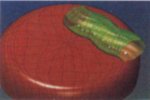 Abstract: We present an efficient and robust algorithm for finding points of collision between time-dependent parametric and implicit surfaces. The algorithm detects simultaneous collisions at multiple points of contact. When the regions of contact form curves or surfaces, it returns a finite set of points uniformly distributed over each contact region.
Abstract: We present an efficient and robust algorithm for finding points of collision between time-dependent parametric and implicit surfaces. The algorithm detects simultaneous collisions at multiple points of contact. When the regions of contact form curves or surfaces, it returns a finite set of points uniformly distributed over each contact region.Collisions can be computed for a very general class of surfaces: those for which inclusion functions can be constructed. Included in this set are the familiar kinds of surfaces and time behaviors encountered in computer graphics.
We use a new interval approach for constrained minimization to detect collisions, and a tangency condition to reduce the dimensionality of the search space. These approaches make interval methods practical for multi-point collisions between complex surfaces. An interval Newton method based on the solution of the interval linear equation is used to speed convergence to the collision time and location. This method is more efficient than the Krawczyk–Moore iteration used previously in computer graphics.
-
John Snyder, ACM SIGGRAPH, 121-130, August 1992. ©ACM 1992.
Keywords: approximation, collision/proximity detection, constraint solution, constrained minimization, constructive solid geometry (CSG), implicit curve, inclusion function, iso-curve, silhouette.
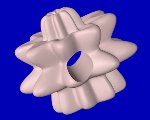 Abstract: This paper discusses how interval analysis can be used to solve a wide variety of problems in computer graphics. These problems include ray tracing, interference detection, polygonal decomposition of parametric surfaces, and CSG on solids bounded by parametric surfaces. Only two basic algorithms are required: SOLVE, which computes solutions to a system of constraints, and MINIMIZE, which computes the global minimum of a function, subject to a system of constraints.We present algorithms for SOLVE and MINIMIZE using interval analysis as the conceptual framework. Crucial to the technique is the creation of “inclusion functions” for each constraint and function to be minimized. Inclusion functions compute a bound on the range of a function, given a similar bound on its domain, allowing a branch and bound approach to constraint solution and constrained minimization. Inclusion functions also allow the MINIMIZE algorithm to compute global rather than local minima, unlike many other numerical algorithms.
Abstract: This paper discusses how interval analysis can be used to solve a wide variety of problems in computer graphics. These problems include ray tracing, interference detection, polygonal decomposition of parametric surfaces, and CSG on solids bounded by parametric surfaces. Only two basic algorithms are required: SOLVE, which computes solutions to a system of constraints, and MINIMIZE, which computes the global minimum of a function, subject to a system of constraints.We present algorithms for SOLVE and MINIMIZE using interval analysis as the conceptual framework. Crucial to the technique is the creation of “inclusion functions” for each constraint and function to be minimized. Inclusion functions compute a bound on the range of a function, given a similar bound on its domain, allowing a branch and bound approach to constraint solution and constrained minimization. Inclusion functions also allow the MINIMIZE algorithm to compute global rather than local minima, unlike many other numerical algorithms.Some very recent theoretical results are presented regarding existence and uniqueness of roots of nonlinear equations, and global parameterizability of implicitly described manifolds. To illustrate the power of the approach, the basic algorithms are further developed into a new algorithm for the approximation of implicit curves.
-
John Snyder, Jim Kajiya, ACM SIGGRAPH, 369-378, August 1992. ©ACM 1992
Keywords: GENMOD, geometric modeling, parametric shape/surface, procedural geometry, swept surface.
 Abstract: This paper discusses a new, symbolic approach to geometric modeling called generative modeling. The approach allows specification, rendering, and analysis of a wide variety of shapes including 3D curves, surfaces, and solids, as well as higher-dimensional shapes such as surfaces deforming in time, and volumes with a spatially varying mass density. The system also supports powerful operations on shapes such as “reparameterize this curve by arclength”, “compute the volume, center of mass, and moments of inertia of the solid bounded by these surfaces”, or “solve this constraint or ODE system”. The system has been used for a wide variety of applications, including creating surfaces for computer graphics animations, modeling the fur and body shape of a teddy bear, constructing 3D solid models of elastic bodies, and extracting surfaces from magnetic resonance (MR) data.
Abstract: This paper discusses a new, symbolic approach to geometric modeling called generative modeling. The approach allows specification, rendering, and analysis of a wide variety of shapes including 3D curves, surfaces, and solids, as well as higher-dimensional shapes such as surfaces deforming in time, and volumes with a spatially varying mass density. The system also supports powerful operations on shapes such as “reparameterize this curve by arclength”, “compute the volume, center of mass, and moments of inertia of the solid bounded by these surfaces”, or “solve this constraint or ODE system”. The system has been used for a wide variety of applications, including creating surfaces for computer graphics animations, modeling the fur and body shape of a teddy bear, constructing 3D solid models of elastic bodies, and extracting surfaces from magnetic resonance (MR) data.Shapes in the system are specified using a language which builds multidimensional parametric functions. The language is based on a set of symbolic operators on continuous, piecewise differentiable parametric functions. We present several shape examples to show how conveniently shapes can be specified in the system. We also discuss the kinds of operators useful in a geometric modeling system, including arithmetic operators, vector and matrix operators, integration, differentiation, constraint solution, and constrained minimization. Associated with each operator are several methods, which compute properties about the parametric functions represented with the operators. We show how many powerful rendering and analytical operations can be supported with only three methods: evaluation of the parametric function at a point, symbolic differentiation of the parametric function, and evaluation of an inclusion function for the parametric function.
Like CSG, and unlike most other geometric modeling approaches, this modeling approach is closed, meaning that further modeling operations can be applied to any results of modeling operations, yielding valid models. Because of this closure property, the symbolic operators can be composed very flexibly, allowing the construction of higher-level operators without changing the underlying implementation of the system. Because the modeling operations are described symbolically, specified models can capture the designer’s intent without approximation error.
[paper] [figures] [Caltech project page (code download)] [wiki]
-
John Snyder, Steve Gabriel, Ronen Barzel, In Graphics Gems III, edited by David Kirk, Academic Press, San Diego, 1992.
Keywords: filtering, rendering on graphics hardware, sampling, video fields.
 Abstract: Lively and dynamic motion can make exciting computer-generated images and animations. Typically, each individual image is rendered at a single instant of time. For a single image of a moving subject, this conveys no sense of motion. For an animation, this can result in extremely objectionable strobing (time-aliasing) artifacts.
Abstract: Lively and dynamic motion can make exciting computer-generated images and animations. Typically, each individual image is rendered at a single instant of time. For a single image of a moving subject, this conveys no sense of motion. For an animation, this can result in extremely objectionable strobing (time-aliasing) artifacts.Aliasing in time can be reduced by motion blur; that is, by averaging or filtering images at many instants of time to create a result in which moving objects are blurred. Motion blur techniques for ray tracing are relatively well understood, involving the association of different time values for each ray cast (Cook et al., 1984). This paper presents a motion blur technique suitable for graphics workstations having fast z-buffer rendering. The essential result is fast, high-quality motion blur is achieved simply by 1) supersampling in time using a temporal box filter, and 2) computing images on fields, rather than frames, for video animations.
-
John Snyder, Academic Press, San Diego, 1992.
Keywords: GENMOD, geometric modeling, parametric shape/surface, procedural geometry, swept surface.
 Foreword (by James T. Kajiya): The inquiry into representation, manipulation, and analysis of shape with computers is one of the central themes of computer graphics. In fact, one could say that computer graphics was born when Ivan Sutherland had the idea that Geometry is Structured Data. Before that, people merely used computers as automated graph paper; after that, geometry could be manipulated by computer.
Foreword (by James T. Kajiya): The inquiry into representation, manipulation, and analysis of shape with computers is one of the central themes of computer graphics. In fact, one could say that computer graphics was born when Ivan Sutherland had the idea that Geometry is Structured Data. Before that, people merely used computers as automated graph paper; after that, geometry could be manipulated by computer.Modeling is an area where, every once in a while, a dazzling new idea will have implications that are explored in years of hard research work, system building, and eventually commercial products. The list of such ideas is short: certainly included are homogeneous coordinates, Coons surfaces, constructive solid geometry, and NURBS.
This book is about an idea that may be a candidate for that short list. During the time I’ve watched John Snyder develop these ideas, my understanding of shape has taken a profound transformation. John’s work has taught me that every shape has an inner logic — a way it should be thought about. That logic is captured in a meta-shape.
Before this work, I thought about a shape as a collection of polygons, or a sculpted surface. But that view is very limited. With a sculpted surface, there’s really no difference between a spoon shape and a chair shape; it’s all a matter of positioning the control points in the right places. But a spoon shape has an inner logic shared by all spoons — and that logic is completely different from that of a chair.
John and I have spent many hours trying to discover the logic of different everyday shapes. It’s an intellectually challenging and exciting endeavor, one that is quite pleasurable when one hits on the right logic of a shape. Because of this, shapes are no longer just inscrutable lumps, but a series of puzzles— sometimes easy and sometimes difficult.
Do you want to read this book? If you have a serious interest in computer graphics, it’s for you. You should also have some experience in the trade. If you’ve completed an introductory course, made some pictures, and attempted to produce an ambitious picture or animation, you’re experienced. Even if your primary interest is in image synthesis or animation, modeling should be important to you. There’s an old saying at Caltech that has proved true many times: “Good modeling can save bad rendering, but good rendering can’t save bad modeling.”
Preface: The purpose of this book is to present a new, symbolic approach to shape representation that I believe is useful to the CAD/CAM and computer graphics communities. This book primarily addresses two audiences. First, it is intended for people who want to know how human beings can specify and manipulate shape. I believe the representational abstraction described in this book to be elegant, powerful, and suitable for a new generation of commercial CAD programs. The specific implementation I describe is just a first step toward the realization of a truly capable and easy to use geometric modeling system. It is my hope that this first step nevertheless demonstrates the merits of the representational abstraction, and will encourage its incorporation in future CAD and animation programs.
Second, it is intended for people working in the area of computational geometry who are interested in a new, robust class of algorithms for manipulating shapes. This class of algorithms employs interval analysis, and includes algorithms for ray tracing, interference detection, polygonal decomposition of parametric surfaces, CSG on solids bounded by parametric surfaces, and offset operations on parametric curves and surfaces. These algorithms can be implemented separately from the modeling system described in this book. However, the inclusion functions on which these algorithms depend are naturally implemented in the system described here, with each symbolic operator having an inclusion function method, thus allowing inclusion functions for the arbitrary composition of the operators. (This kind of includion function is termed a “natural interval extension” in Chapter 5.) The result is that the algorithms can be applied to a great variety of shapes, while the implementation remains simple.What exactly is generative modeling and what good is it? Because of the novelty of the generative modeling approach to geometric modeling, I believe some answer to this question should be given in the Preface, although it is answered much more completely in Chapters 1 and 2.
Shapes in the generative modeling approach are represented as multidimensional, continuous, piecewise-differentiable parametric functions. A set of symbolic operators on such functions is used to build complicated shapes by simple composition of the symbolic operators. The book describes a language that allows the procedural specification of shapes represented with these symbolic operators. Many shape examples are presented to show how conveniently shapes can be specified using this language. My intent here is not to extol the particular syntax of the modeling language presented, but instead to show the usefulness of modeling by composing high-level, symbolic operators. The language described here was chosen because it makes these ideas concrete, and because it is part of a working system.
This book also discusses the kinds of operators useful in a geometric modeling system, including arithmetic operators, vector and matrix operators, integration, differentiation, constraint solution, and constrained minimization. Associated with each operator are several methods that compute properties about the parametric function represented with the operators. This book shows how numerous rendering and analytical operations can be supported with only three methods: evaluation of the parametric function at a point, symbolic differentiation of the parametric function, and evaluation of an inclusion function for the parametric function (inclusion functions are defined in Chapter 5).
One advantage of the generative modeling approach is that it allows specification, rendering, and analysis of many kinds of shapes, including the standard 3D curves, surfaces, and solids, as well as higher-dimensional shapes such as surfaces deforming in time, and volumes with a spatially varying mass density. The approach also supports powerful, high-level operations on shapes such as “reparameterize this curve by arclength”, “compute the volume, center of mass, and moments of inertia of the solid bounded by these surfaces”, or “solve this constraint or ODE system.” An implementation of this approach, called GENMOD, has been used in our computer graphics research lab at the California Institute of Technology for a wide variety of applications, including creating surfaces for computer graphics animations, modeling the body shape and fur of a teddy bear, constructing 3D solid models of elastic bodies, and extracting models from MRI data. In fact, almost all the figures in this book were made using GENMOD.
Unlike most other geometric modeling approaches, a further advantage of this approach is that it is closed, meaning that modeling operations can be applied to any results of earlier modeling operations, yielding valid models. Because of this closure property, the symbolic operators can be composed very flexibly, allowing the construction of higher-level operators without changing the underlying implementation of the system. Because the modeling operations are described symbolically, specified models can capture the designer’s intent without approximation error.
The book is organized as follows: Chapter 1 examines how geometric modeling approaches may be compared, disucsses some approaches used in the past and their problems, and introduces the generative modeling approach. Chapter 2 answers the question, “What is a generative model?” and traces the developement of the generative modeling approach. Chapter 3 presents a series of shape specification examples. Rendering of generative models is treated in Chapter 4. Chapters 5 and 6 discuss how robust tools for the analysis of shape can be developed using the technique of interval analysis. Inclusion functions, and their use in creating algorithms to solve systems of constraints and constrained minimization probelsm, are treated in Chapter 5. These algorithms, in turn, are applied to higher-level problems in geometric modeling, such as CSG, in Chapter 6. Appendix A provides an overview of the GENMOD language. Appendix B presents more elaborate examples of GENMOD specifications that do not fit conveniently in the text. Proofs of the interval analysis theorems used in Chapters 5 and 6 can be found in Appendix C.As the reader will undoubtedly realize, much of the work presnted here is research in progress. I therefore have tried to point out areas for future improvement, as well as describe what has already been implemented. Although much remains to be done, what has been done gives me confidence that this approach may lead to the solution of many nagging problems in geometric modeling. It is my hope that the ideas are described adequately enough to stimulate continuing, fruitful work in this are of symbolic, interval-based geometric modeling.
Note: my book is long out of print.
-
John Snyder, Alan Barr, ACM SIGGRAPH, 119-128, July 1987. ©ACM 1987.
Keywords: lists and 3D grids, parametric surface, spatial data structures, triangle mesh.
 Abstract: An approach to ray tracing complex models containing mathematically defined surfaces is presented. Parametric and implicit surfaces, and boolean combinations of these, are first tessellated into triangles. The resulting triangles from many such surfaces are organized in a hierarchy of lists and 3D grids, allowing efficient calculation of ray/model intersections. The technique has been used to ray trace models containing billions of triangles and surfaces never before ray traced. The organizing scheme developed is also independently useful for efficiently ray tracing any complex model, whether or not it contains surface tessellations.
Abstract: An approach to ray tracing complex models containing mathematically defined surfaces is presented. Parametric and implicit surfaces, and boolean combinations of these, are first tessellated into triangles. The resulting triangles from many such surfaces are organized in a hierarchy of lists and 3D grids, allowing efficient calculation of ray/model intersections. The technique has been used to ray trace models containing billions of triangles and surfaces never before ray traced. The organizing scheme developed is also independently useful for efficiently ray tracing any complex model, whether or not it contains surface tessellations.

